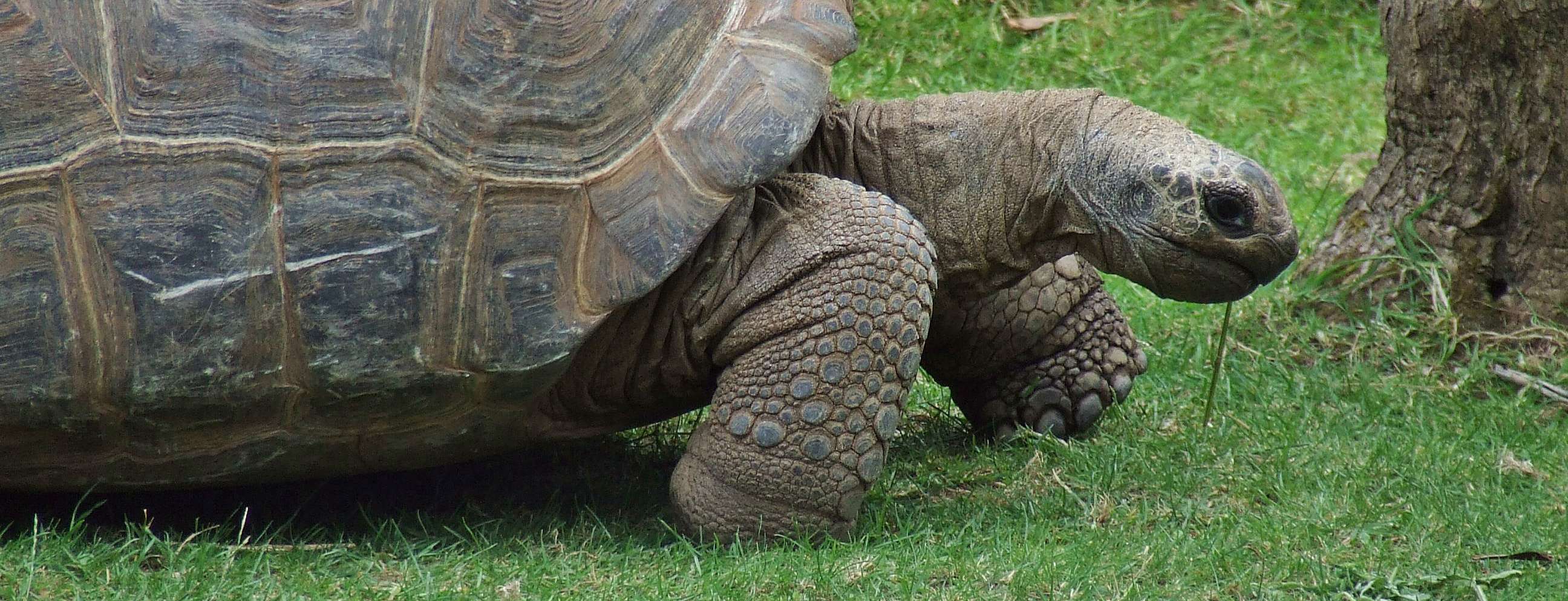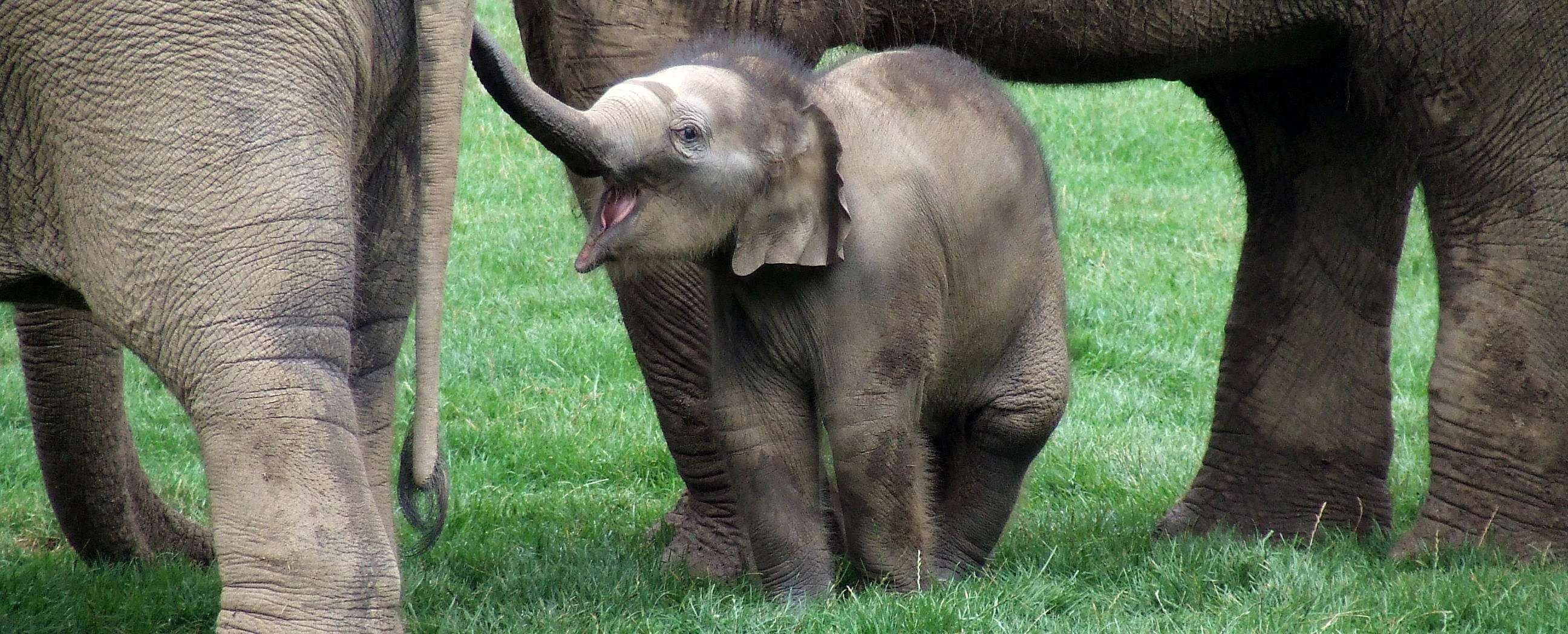Európa állatkertjei
ZOOlogical Gardens of EuROPE
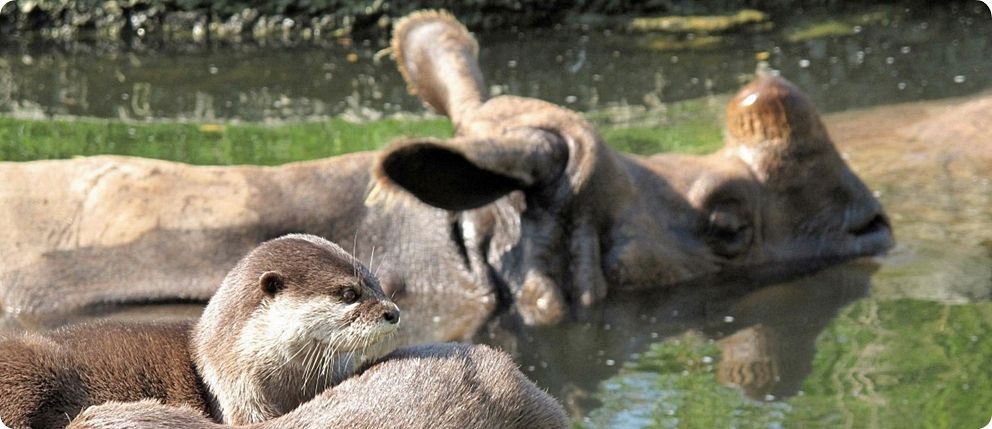
MIXED-SPECIES EXHIBITS WITH CARNIVORANS VIII.
Mixed-species exhibits with Weasels and relatives (Mustelidae) and Skunks (Mephitidae)
Written by KRISZTIÁN SVÁBIK
Assistant Curator, Budapest Zoo and Botanical Garden, Hungary
Uploaded: 23rd August 2019
Refreshed: 12th June 2020
INTRODUCTION
As many articles and other publications deal with the subject of general advantages and disadvantages of the mixed-species exhibits, instead of this, here I will assemble a detailed list of mixed exhibits involving at least one member of Mustelidae and Mephitidae.
This document purposefully focuses on creating a list of mixed-species exhibits with Weasels and relatives and Skunks, for further and detailed information it is worth contacting the institutions mentioned below. Only a short summary of the general experiences is given here. Many of the listed coexistences are still ongoing at present; many of them are not anymore.
In the list below you can see which species have been kept in mixed exhibits in captivity:
Weasels and relatives, Mustelidae
European Polecat, Mustela putorius Linnaeus, 1758
Zorilla, Ictonyx striatus Perry, 1810
European Mink, Mustela lutreola Linnaeus, 1761
American Mink, Neovison vison Schreber, 1777
European Pine Marten, Martes martes Linnaeus, 1758
Tayra, Eira barbara Linnaeus, 1758
Wolverine, Gulo gulo Linnaeus, 1758
Eurasian Otter, Lutra lutra Linnaeus, 1758
North American River Otter, Lontra canadensis Schreber, 1777
Smooth-coated Otter, Lutrogale perspicillata I. Geoffroy Saint-Hilaire, 1826
Spotted-necked Otter, Hydrictis maculicollis Lichtenstein, 1835
Asian Small-clawed Otter, Aonyx cinereus Illiger, 1815
African Clawless Otter, Aonyx capensis Schinz, 1821
Giant Otter, Pteronura brasiliensis Gmelin, 1788
Sea Otter, Enhydra lutris Linnaeus, 1758
European Badger, Meles meles Linnaeus, 1758
Hog Badger, Arctonyx collaris F.G. Cuvier, 1825
Large-toothed Ferret-badger, Melogale personata I. Geoffroy Saint-Hilaire, 1831
American Badger, Taxidea taxus Schreber, 1777
Skunks, Mephitidae
Striped Skunk, Mephitis mephitis Schreber, 1776
LIST OF SPECIES COMBINATIONS - MUSTELIDAE
The list shows examples of species combinations with at least one mustelid species combined with the taxa below
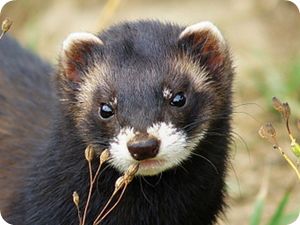 European Polecat, Mustela putorius (Photo © Peter Trimming)
European Polecat, Mustela putorius (Photo © Peter Trimming)
European Rabbit, Oryctolagus cuniculus
Northern Raccoon, Procyon lotor
Zorilla, Ictonyx striatus (Photo © Alexander Meyer)
Tree Shrew, Tupaia sp.
Bushbaby, Galago sp.
Crested Porcupine, Hystrix cristata
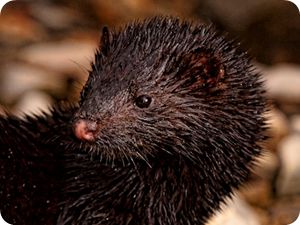 European Mink, Mustela lutreola (Photo © Paco Gómez)
European Mink, Mustela lutreola (Photo © Paco Gómez)
Northern Raccoon, Procyon lotor
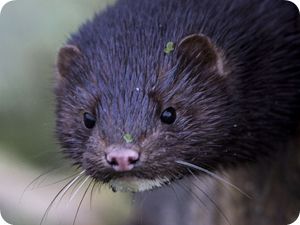 American Mink, Neovison vison (Photo © British Wildlife Centre)
American Mink, Neovison vison (Photo © British Wildlife Centre)
Raccoon Dog, Nyctereutes procyonoides
Northern Raccoon, Procyon lotor
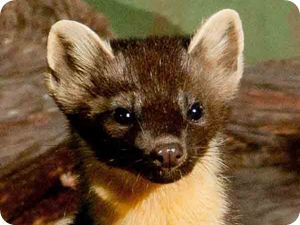 European Pine Marten, Martes martes (Photo © Ellis Lawrence)
European Pine Marten, Martes martes (Photo © Ellis Lawrence)
European Badger, Meles meles
Tayra, Eira barbara (Photo © Krisztián Svábik)
Black-capped Capuchin, Sapajus apella
South American Coati, Nasua nasua
Crab-eating Raccoon, Procyon cancrivorus
Wolverine, Gulo gulo (Photo © Tamás Boros)
Brown Bear, Ursus arctos
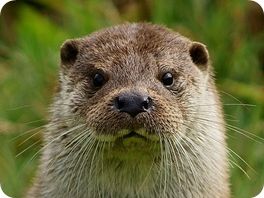 Eurasian Otter, Lutra lutra (Photo © Peter Trimming)
Eurasian Otter, Lutra lutra (Photo © Peter Trimming)
Francois’ Langur, Trachypithecus francoisi
White-handed Gibbon, Hylobates lar
Siamang, Symphalangus syndactylus
Indian Giant Flying Squirrel, Petaurista philippensis
Alpine Marmot, Marmota marmota
Red Fox, Vulpes vulpes
Striped Skunk, Mephitis mephitis
Northern Raccoon, Procyon lotor
Chamois, Rupicapra rupicapra
Mute Swan, Cygnus olor
North American River Otter, Lontra canadensis (Photo © Krisztián Svábik)
North American Porcupine, Erethizon dorsatum
Canadian Beaver, Castor canadensis
Grey Seal, Halichoerus grypus
Smooth-coated Otter, Lutrogale perspicillata (Photo © Krisztián Svábik)
Bornean Gibbon, Hylobates muelleri
Binturong, Arctictis bintrong
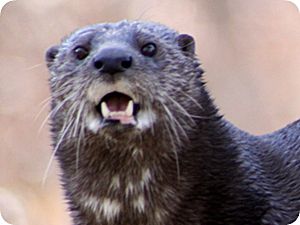 Spotted-necked Otter, Hydrictis maculicollis (Photo © Derek Keats)
Spotted-necked Otter, Hydrictis maculicollis (Photo © Derek Keats)
Allen’s Swamp Monkey, Allenopithecus nigroviridis
Schmidt’s Guenon, Cercopithecus ascanius schmidti
De Brazza’s Monkey, Cercopithecus neglectus
Spot-nosed Monkey, Cercopithecus petaurista
Francois’ Langur, Trachypithecus francoisi
Red River Hog, Potamochoerus porcus
African Forest Buffalo, Syncerus caffer nanus
Goliath Heron, Ardea goliath
Fish, Pisces
Asian Small-clawed Otter, Aonyx cinereus (Photo © Krisztián Svábik)
Red Ruffed Lemur, Varecia rubra
Black-and-white Ruffed Lemur, Varecia variegata
Brown-headed Spider Monkey, Ateles fusciceps
Black-capped Capuchin, Sapajus apella
Black-and-gold Howler Monkey, Alouatta caraya
Crab-eating Macaque, Macaca fascicularis
Celebes Crested Macaque, Macaca nigra
Bonnet Macaque, Macaca radiata
Lion-tailed Macaque, Macaca silenus
Barbary Macaque, Macaca sylvanus
Tonkean Macaque, Macaca tonkeana
Northern Plains Grey Langur, Semnopithecus entellus
Javan Langur, Trachypithecus auratus
Silvery Langur, Trachypithecus cristatus
Francois’ Langur, Trachypithecus francoisi
Dusky Leaf Monkey, Trachypithecus obscurus
Northern White-cheeked Gibbon, Nomascus leucogenys
White-handed Gibbon, Hylobates lar
Pileated Gibbon, Hylobates pileatus
Siamang, Symphalangus syndactylus
Proboscis Monkey, Nasalis larvatus
Bornean Orangutan, Pongo pygmaeus
Sumatran Orangutan, Pongo abelii
Capybara, Hydrochoerus hydrochaeris
Prevost’s Squirrel, Callosciurus prevostii
Black Giant Squirrel, Ratufa bicolor
Indian Giant Flying Squirrel, Petaurista philippensis
Indian Crested Porcupine, Hystrix indica
Lesser Dog-faced Fruit Bat, Cynopterus brachyotis
Island Flying Fox, Pteropus hypomelanus
Rodrigues Flying Fox, Pteropus rodricensis
Lion, Panthera leo
Binturong, Arctictis binturong
Common Palm Civet, Paradoxurus hermaphroditus
Corsac Fox, Vulpes corsac
Sloth Bear, Melurus ursinus
Andean Bear, Tremarctos ornatus
Red Panda, Ailurus fulgens
Northern Raccoon, Procyon lotor
South American Coati, Nasua nasua
South American tapir, Tapirus terrestris
Malayan Tapir, Tapirus indicus
Greater One-horned Rhinoceros, Rhinoceros unicornis
Sulawesi Babirusa, Babyrousa celebensis
Visayan Warty Pig, Sus cebifrons
Lesser Oriental Chevrotain, Tragulus kanchil
Reeves’ Muntjac, Muntiacus reevesi
Lowland Anoa, Bubalus depressicornis
Aoudad, Ammotragus lervia
Southern Cassowary, Casuarius casuarius
Green-backed Heron, Butorides striata
Green Peafowl, Pavo muticus
Great Hornbill, Buceros bicornis
Black Hornbill, Anthracoceros malayanus
Blue-bellied Roller, Coracias cyanogaster
Black-naped Oriole, Oriolus chinensis
Black-hooded Oriole, Oriolus xanthornus
Oriental Magpie-robin, Copsychus saularis
Brahminy Starling, Temenuchus pagodarum
Black-capped Bulbul, Pycnonotus melanicterus
Blue-winged Pitta, Pitta moluccensis
Asian Fairy-bluebird, Irena puella
Golden-fronted Leafbird, Chloropsis aurifrons
Pale-bellied White-eye, Zosterops consobrinorum
Common Hill Myna, Gracula religiosa
Northern River Terrapin, Batagur baska
Slender-snouted Crocodile, Mecistops cataphractus
Common Water Monitor, Varanus salvator
Tilapia, Oreochromis sp.
Giant Pangasius, Pangasius sanitwongsei
Red-bellied Pacu, Piaractus brachypomus
Hemiodus sp.
Leporinus sp.
Butterflies, Lepidoptera
African Clawless Otter, Aonyx capensis (Photo © Steve Hofhine)
Guenon, Cercopithecus sp.
De Brazza’s Monkey, Cercopithecus neglectus
Giant Otter, Pteronura brasiliensis (Photo © Krisztián Svábik)
Silvery Marmoset, Mico argentatus
Spider Monkey, Ateles sp.
White-faced Saki, Pithecia pithecia
Capybara, Hydrochoerus hydrochaeris
South American tapir, Tapirus terrestris
Caiman, Caiman sp.
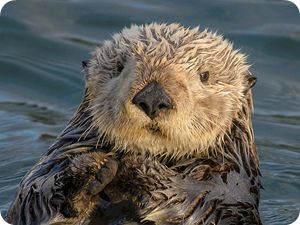 See Otter, Enhydra lutris (Photo © Marshal Hedin)
See Otter, Enhydra lutris (Photo © Marshal Hedin)
Harbor Seal, Phoca vitulina
European Badger, Meles meles (Photo © Anita Mazács)
Red Fox, Vulpes vulpes
European Pine Marten, Martes martes
Common Raven, Corvus corax
Hog Badger, Arctonyx collaris (Photo © Alexander Meyer)
Binturong, Arctictis binturong
Masked Palm Civet, Paguma larvata
Northern Raccoon, Procyon lotor
Striped Skunk, Mephitis mephitis
Large-toothed Ferret-badger, Melogale personata (Photo © Alexander Meyer)
Common Palm Civet, Paradoxurus hermaphroditus
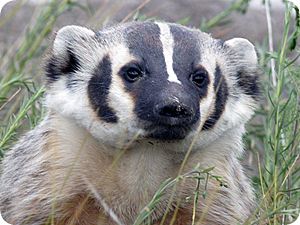 American Badger, Taxidea taxus (Photo © James Perdue)
American Badger, Taxidea taxus (Photo © James Perdue)
Northern Raccoon, Procyon lotor
LIST OF SPECIES COMBINATIONS - MEPHITIDAE
The list shows examples of species combinations with at least one skunk species combined with the taxa below
Striped Skunk, Mephitis mephitis (Photo © Krisztián Svábik)
Opossum, Didelphis sp.
Southern Hairy-nosed Wombat, Lasiorhinus latifrons
Southern Three-banded Armadillo, Tolypeutes matacus
Northern Tree Shrew, Tupaia belangeri
Black-and-white Ruffed Lemur, Varecia variegata
Garnett’s Greater Galago, Otolemur garnettii
Nancy Ma’s Night Monkey, Aotus nancymaae
Eurasian Red Squirrel, Sciurus vulgaris
American Red Squirrel, Tamiasciurus hudsonicus
Southern Flying Squirrel, Glaucomys volans
Black-tailed Prairie Dog, Cynomys ludovicianus
Woodchuck, Marmota monax
Crested Porcupine, Hystrix sp.
North American Porcupine, Erethizon dorsatum
Agouti, Dasyprocta sp.
Masked Palm Civet, Paguma larvata
Red Fox, Vulpes vulpes
Northern Raccoon, Procyon lotor
South American Coati, Nasua nasua
White-nosed Coati, Nasua narica
Ringtail, Bassariscus astutus
Eurasian Otter, Lutra lutra
Hog Badger, Arctonyx collaris
Golden Pheasant, Chrysolophus pictus
Sandhill Crane, Antigone canadensis
Domestic Pigeon, Columba livia f. domestica
Burrowing Parrot, Cyanoliseus patagonus
Eastern Box Turtle, Terrapene carolina
LIST OF MIXED-SPECIES EXHIBITS WITH LOCATIONS - MUSTELIDAE
The list shows specific examples of mixed-species exhibits involving at least one mustelid species combined with the taxa below, with indication of the institution(s) where they have been tried out
 European Polecat, Mustela putorius
European Polecat, Mustela putorius
Combined species:
- European Polecat, Mustela putorius
- European Rabbit, Oryctolagus cuniculus
unknown institution
Combined species:
- European Polecat, Mustela putorius
- Northern Raccoon, Procyon lotor
Institution(s): Tierpark Gotha (Germany), Tierpark Hexentanzplatz (Thale, Germany)
Combined species:
- Ferret, Mustela putorius f. furo
- Northern Raccoon, Procyon lotor
Institution(s): Wildpark Bad Mergentheim (Germany), Wildparadies Tripsdrill (Cleebronn, Germany)
Zorilla, Ictonyx striatus
Combined species:
- Zorilla, Ictonyx striatus
- Tree Shrew, Tupaia sp.
- Bushbaby, Galago sp.
- Crested Porcupine, Hystrix cristata
unkown institution
 European Mink, Mustela lutreola
European Mink, Mustela lutreola
Combined species:
- European Mink, Mustela lutreola
- Northern Raccoon, Procyon lotor
Institution(s): Zoo Heidelberg (Germany)
 American Mink, Neovison vison
American Mink, Neovison vison
Combined species:
- American Mink, Neovison vison
- Northern Raccoon, Procyon lotor
Institution(s): Parc Animalier des Pyrénées (Ayzac-Ost, France)
Combined species:
- American Mink, Neovison vison
- Raccoon Dog, Nyctereutes procyonoides
- Northern Raccoon, Procyon lotor
Institution(s): Wildpark Mölln (Germany)
 European Pine Marten, Martes martes
European Pine Marten, Martes martes
Combined species:
- European Pine Marten, Martes martes
- European Badger, Meles meles
Institution(s): Alpenzoo Innsbruck (Austria)
Tayra, Eira barbara
Combined species:
- Tayra, Eira barbara
- Black-capped Capuchin, Sapajus apella
- South American Coati, Nasua nasua
Institution(s): Parque de las Leyendas (Lima, Peru)
Tayra (Eira barbara) and Black-capped Capuchins (Sapajus apella)
Parque de las Leyendas, Lima, Peru
Photo © Nick Hadad
Combined species:
- Tayra, Eira barbara
- Crab-eating Raccoon, Procyon cancrivorus
Institution(s): Eco Zoologico San Martín (Banos, Ecuador)
Wolverine, Gulo gulo
Combined species:
- Wolverine, Gulo gulo
- Brown Bear, Ursus arctos
Institution(s): Tierpark Dählhölzli (Bern, Switzerland), Skansen (Stockholm, Sweden), Zoo d'Amnéville (France)
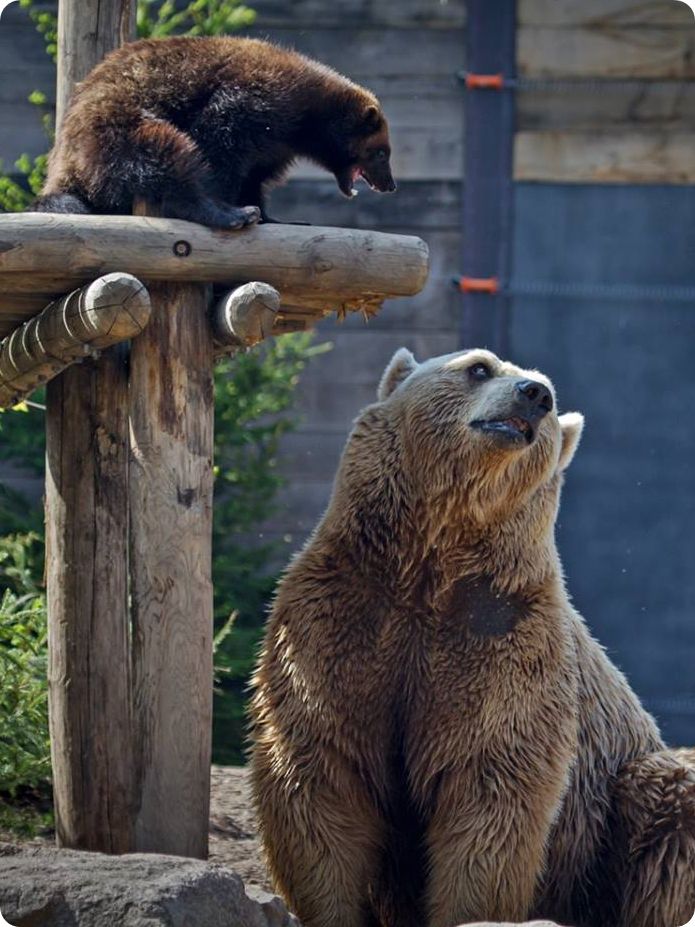
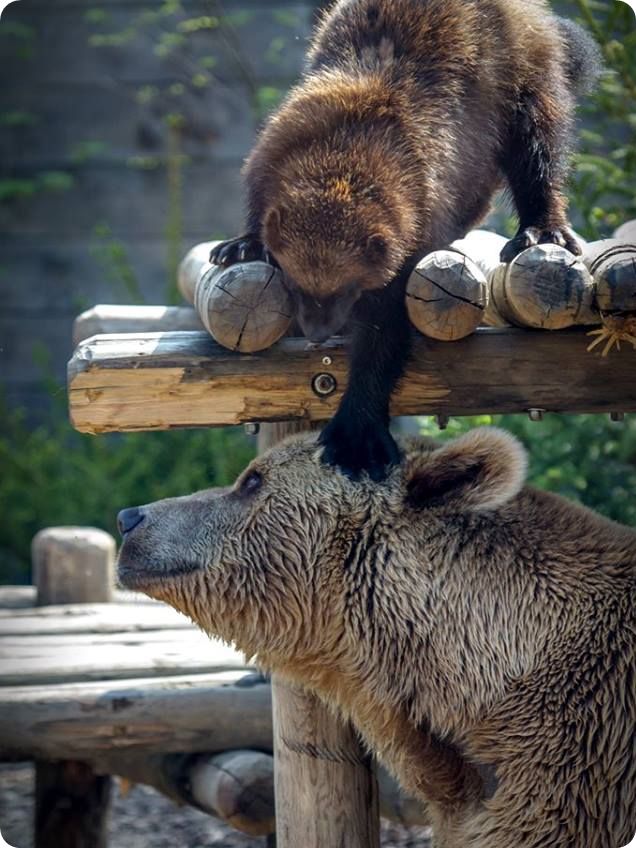
Wolverine (Gulo gulo gulo) and European Brown Bear (Ursus arctos arctos)
Zoo d'Amnéville, France
Photos © Ingrid Klaus
 Eurasian Otter, Lutra lutra
Eurasian Otter, Lutra lutra
Combined species:
- Eurasian Otter, Lutra lutra
- Francois’ Langur, Trachypithecus francoisi
- Indian Giant Flying Squirrel, Petaurista philippensis
Institution(s): San Diego Zoo (California, United States of America)
Combined species:
- Eurasian Otter, Lutra lutra
- White-handed Gibbon, Hylobates lar
- Siamang, Symphalangus syndactylus
Institution(s): San Diego Zoo (California, United States of America)
Combined species:
- Eurasian Otter, Lutra lutra
- Alpine Marmot, Marmota marmota
- Chamois, Rupicapra rupicapra
Institution(s): Zoo Salzburg Hellbrunn (Austria)
Combined species:
- Eurasian Otter, Lutra lutra
- Red Fox, Vulpes vulpes
- Northern Raccoon, Procyon lotor
- Striped Skunk, Mephitis mephitis
Institution(s): Zoo sauvage de Saint-Félicien (Quebec, Canada)
Combined species:
- Eurasian Otter, Lutra lutra
- Northern Raccoon, Procyon lotor
Institution(s): Tierpark Görlitz (Germany), Zoo Rostock (Germany), Tierpark Niederfischbach (Germany)
Combined species:
- Eurasian Otter, Lutra lutra
- Mute Swan, Cygnus olor
Institution(s): Tierpark Görlitz (Germany)
North American River Otter, Lontra canadensis
Combined species:
- North American River Otter, Lontra canadensis
- North American Porcupine, Erethizon dorsatum
Institution(s): Zoo New England, Stone Zoo (Stoneham, Massachusetts, United States of America)
Combined species:
- North American River Otter, Lontra canadensis
- Canadian Beaver, Castor canadensis
unknown institution
Combined species:
- North American River Otter, Lontra canadensis
- Grey Seal, Halichoerus grypus
Institution(s): Los Angeles Zoo (California, United States of America)
Smooth-coated Otter, Lutrogale perspicillata
Combined species:
- Smooth-coated Otter, Lutrogale perspicillata
- Bornean Gibbon, Hylobates muelleri
Institution(s): Lok Kawi Wildlife Park (Penampang, Malaysia)
Combined species:
- Smooth-coated Otter, Lutrogale perspicillata
- Binturong, Arctictis binturong
Institution(s): Zoologická zahrada hl. m. Prahy (Czech Republic)
 Spotted-necked Otter, Hydrictis maculicollis
Spotted-necked Otter, Hydrictis maculicollis
Combined species:
- Spotted-necked Otter, Hydrictis maculicollis
- Allen’s Swamp Monkey, Allenopithecus nigroviridis
- Schmidt’s Guenon, Cercopithecus ascanius schmidti
Institution(s): San Diego Zoo (California, United States of America)
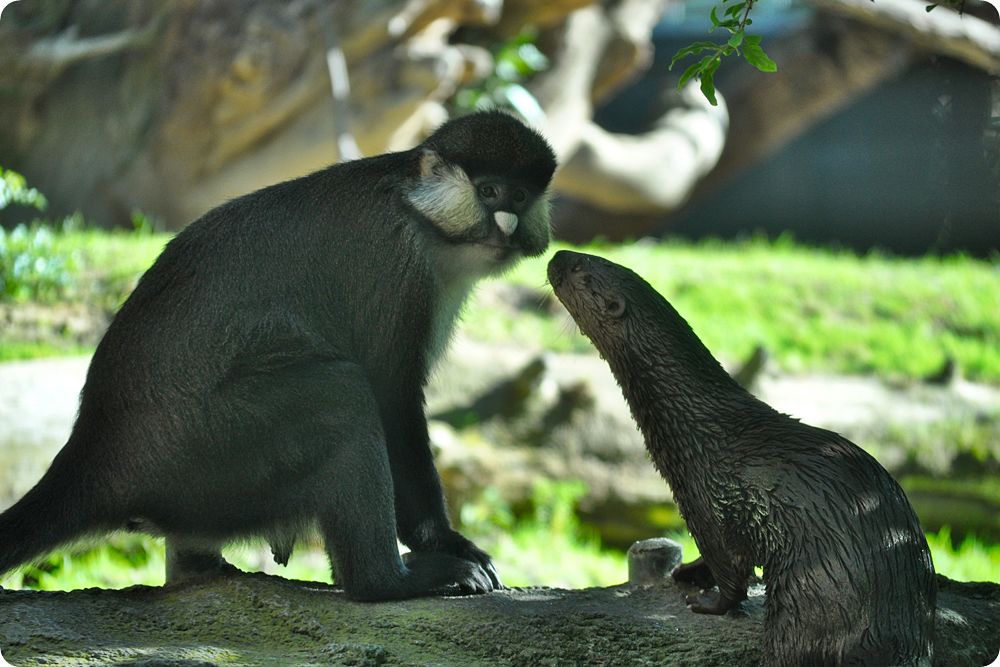
Spotted-necked Otter (Hydrictis maculicollis) and Schmidt’s Guenon (Cercopithecus ascanius schmidti)
San Diego Zoo, California, United States of America
Photo © San Diego Zoo
Combined species:
- Spotted-necked Otter, Hydrictis maculicollis
- Allen’s Swamp Monkey, Allenopithecus nigroviridis
- Schmidt’s Guenon, Cercopithecus ascanius schmidti
- Spot-nosed Monkey, Cercopithecus petaurista
Institution(s): San Diego Zoo (California, United States of America)
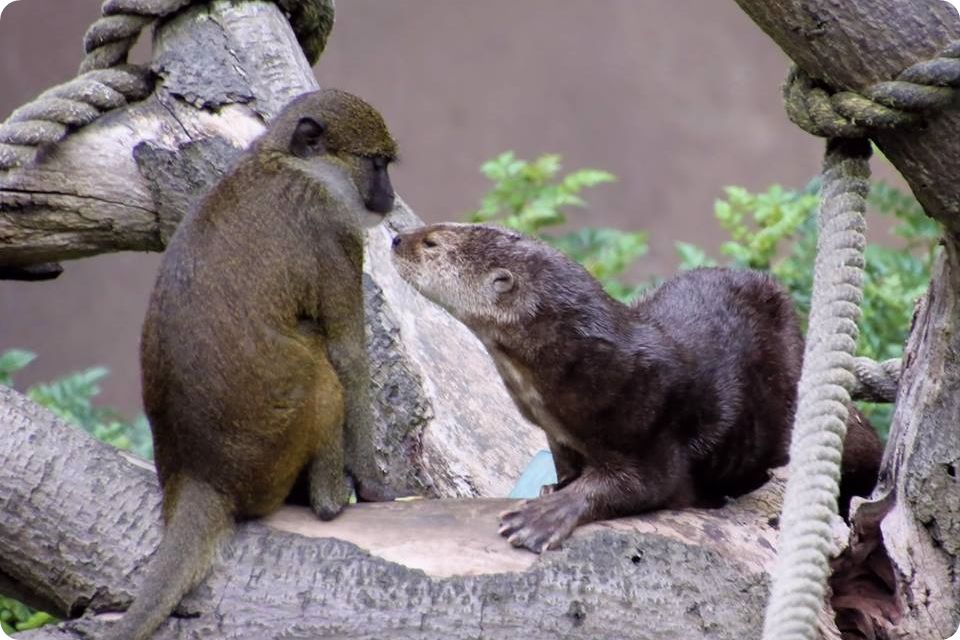
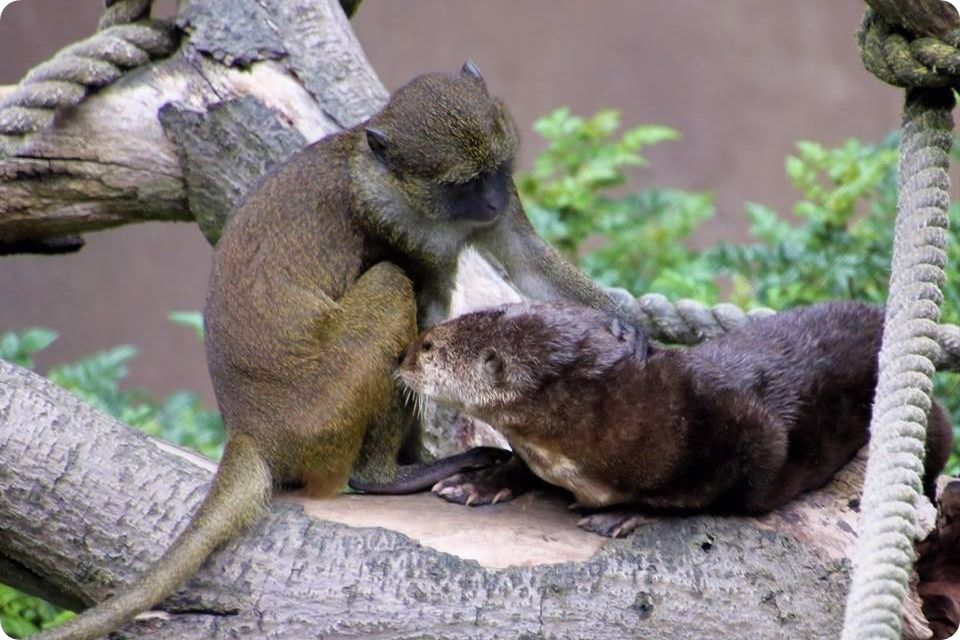
Spotted-necked Otter (Hydrictis maculicollis) and Allen's Swamp Monkey (Allenopithecus nigroviridis)
San Diego Zoo, California, United States of America
Photo © MaryAnn Fuller
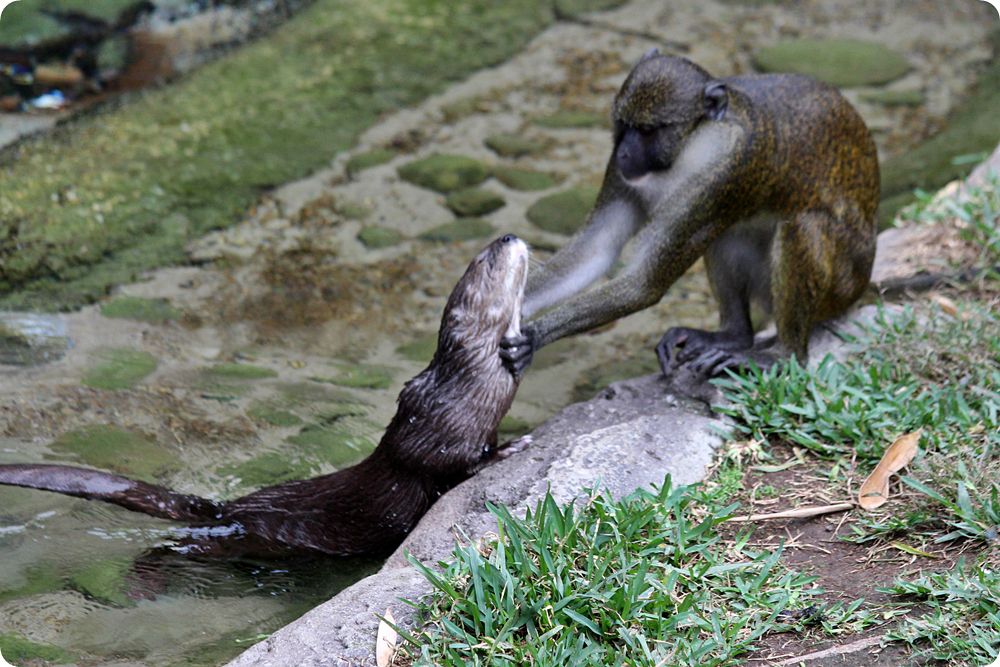
Spotted-necked Otter (Hydrictis maculicollis) and Allen's Swamp Monkey (Allenopithecus nigroviridis)
San Diego Zoo, California, United States of America
Photo © Michelle Leppert
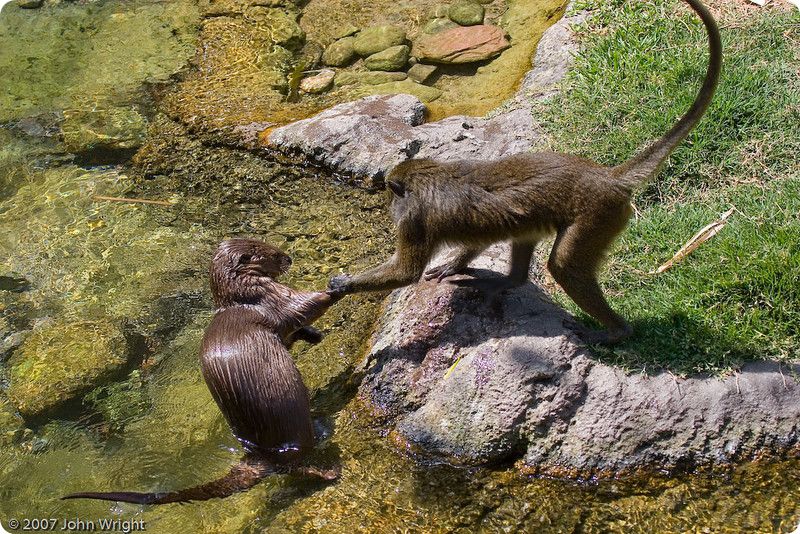
Spotted-necked Otter (Hydrictis maculicollis) and Allen's Swamp Monkey (Allenopithecus nigroviridis)
San Diego Zoo, California, United States of America
Photo © John Wright
Combined species:
- Spotted-necked Otter, Hydrictis maculicollis
- De Brazza’s Monkey, Cercopithecus neglectus
- Red River Hog, Potamochoerus porcus
- African Forest Buffalo, Syncerus caffer nanus
Institution(s): San Diego Zoo (California, United States of America)
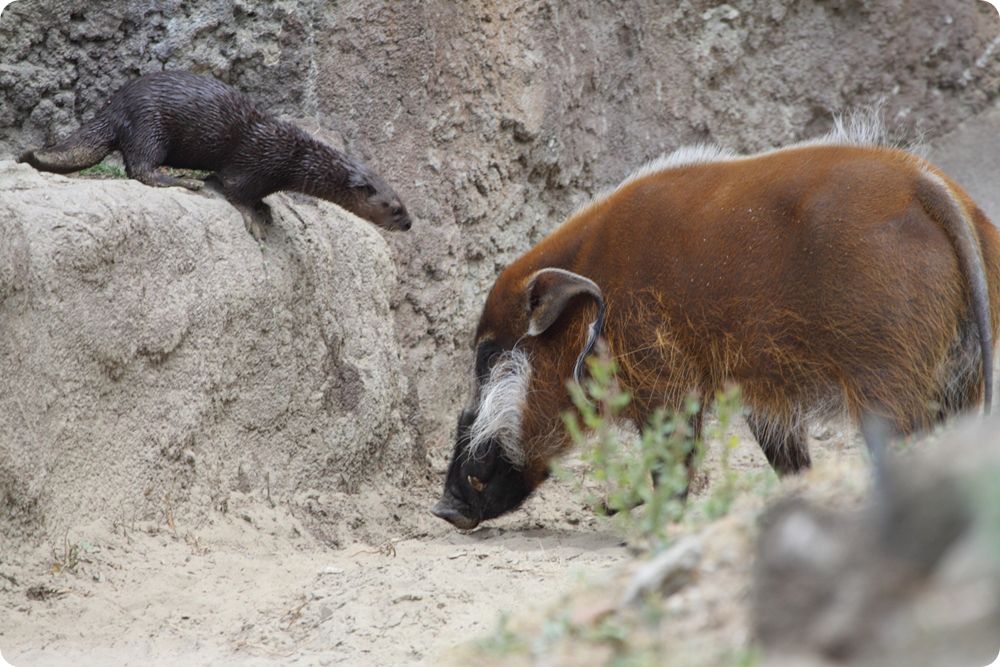
Spotted-necked Otter (Hydrictis maculicollis) and Red River Hog (Potamochoerus porcus)
San Diego Zoo, California, United States of America
Photo © Brent Huffman
Combined species:
- Spotted-necked Otter, Hydrictis maculicollis
- Allen’s Swamp Monkey Allenopithecus nigroviridis
- De Brazza’s Monkey, Cercopithecus neglectus
- African Forest Buffalo, Syncerus caffer nanus
Institution(s): San Diego Zoo (California, United States of America)
Asian Small-clawed Otter, Aonyx cinereus
Combined species:
- Asian Small-clawed Otter, Aonyx cinereus
- Red Ruffed Lemur, Varecia rubra
- Black-and-white Ruffed Lemur, Varecia variegata
Institution(s): Memphis Zoo (Tennessee, United States of America)
Combined species:
- Asian Small-clawed Otter, Aonyx cinereus
- Black-and-gold Howler Monkey, Alouatta caraya
- Andean Bear, Tremarctos ornatus
- South American Coati, Nasua nasua
Institution(s): Jersey Zoo (Trinity, Channel Islands)
.jpg)
Asian Small-clawed Otter (Aonyx cinereus) and Andean Bear (Tremarctos ornatus)
Jersey Zoo, Trinity, Channel Islands
Photo © Jersey Zoo
Combined species:
- Asian Small-clawed Otter, Aonyx cinereus
- Brown-headed Spider Monkey, Ateles fusciceps
- Black-capped Capuchin, Sapajus apella
- Capybara, Hydrochoerus hydrochaeris
- Andean Bear, Tremarctos ornatus
- South American Tapir, Tapirus terrestris
Institution(s): South Lakes Safari Zoo (Dalton-in-Furness, United Kingdom)
Asian Small-clawed Otters (Aonyx cinereus), Andean Bear (Tremarctos ornatus) and Capybaras (Hydrochoerus hydrochaeris)
South Lakes Safari Zoo, Dalton-in-Furness, United Kingdom
Photo © Ben Gilbert
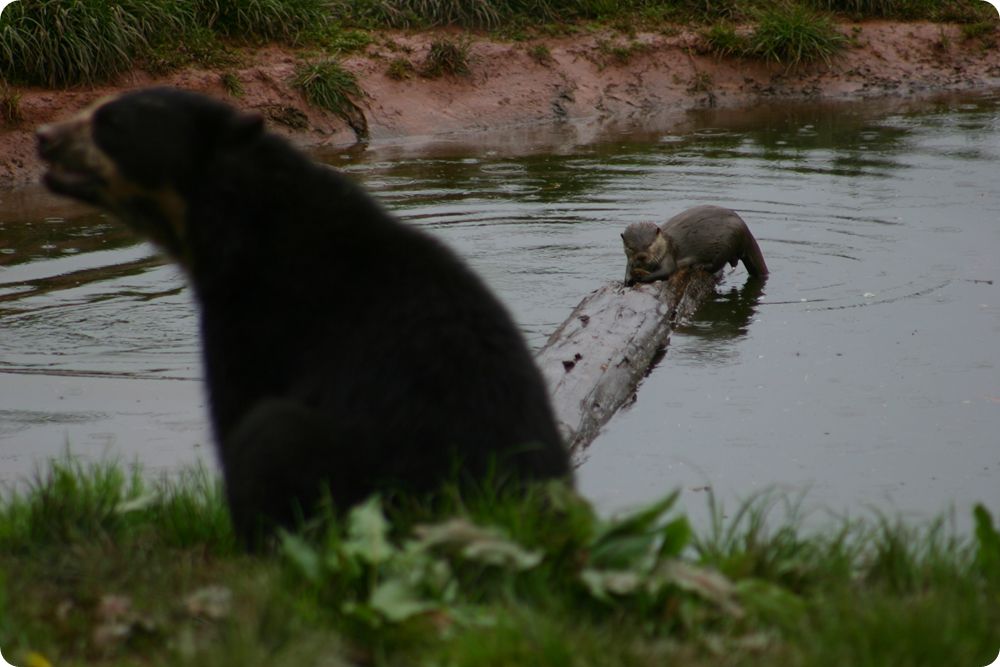
Asian Small-clawed Otter (Aonyx cinereus) and Andean Bear (Tremarctos ornatus)
South Lakes Safari Zoo, Dalton-in-Furness, United Kingdom
Photo © South Lakes Safari Zoo
Combined species:
- Asian Small-clawed Otter, Aonyx cinereus
- Crab-eating Macaque, Macaca fascicularis
Institution(s): Brookfield Zoo (Illinois, United States of America)
Combined species:
- Asian Small-clawed Otter, Aonyx cinereus
- Sulawesi Crested Macaque, Macaca nigra
Institution(s): ZOO Planckendael (Mechelen, Belgium)
Combined species:
- Asian Small-clawed Otter, Aonyx cinereus
- Bonnet Macaque, Macaca radiata
Institution(s): Auckland Zoo (New Zealand), Tokiwa Zoo (Japan)
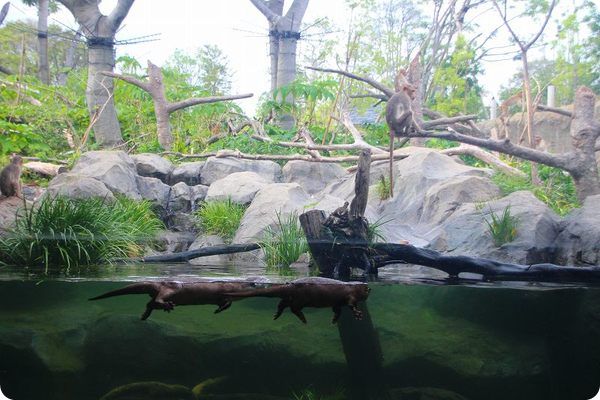
Asian Small-clawed Otters (Aonyx cinereus) and Bonnet Macaques (Macaca radiata)
Tokiwa Zoo, Japan
Photo © Kenji Wako
Asian Small-clawed Otters (Aonyx cinereus) and Bonnet Macaques (Macaca radiata)
Tokiwa Zoo, Japan
Photo © Noriko Kawanabe
Combined species:
- Asian Small-clawed Otter, Aonyx cinereus
- Tonkean Macaque, Macaca tonkeana
Institution(s): Brookfield Zoo (Illinois, United States of America)
Combined species:
- Asian Small-clawed Otter Aonyx cinereus
- Barbary Macaque, Macaca sylvanus
unknown institution
Combined species:
- Asian Small-clawed Otter, Aonyx cinereus
- Barbary Macaque, Macaca sylvanus
- Aoudad, Ammotragus lervia
unknown institution
Combined species:
- Asian Small-clawed Otter, Aonyx cinereus
- Northern Plains Grey Langur, Semnopithecus entellus
- Sumatran Orangutan, Pongo abelii
Institution(s): ZOOM Erlebniswelt (Gelsenkirchen, Germany)
Combined species:
- Asian Small-clawed Otter, Aonyx cinereus
- Javan Langur, Trachypithecus auratus
Institution(s): Bronx Zoo (New York, United States of America)
Combined species:
- Asian Small-clawed Otter, Aonyx cinereus
- Silvery Langur, Trachypithecus cristatus
Institution(s): Bronx Zoo (New York, United States of America), Brookfield Zoo (Illinois, United States of America)
Combined species:
- Asian Small-clawed Otter, Aonyx cinereus
- Silvery Langur, Trachypithecus cristatus
- Binturong, Arctictis binturong
Institution(s): Colchester Zoo (United Kingdom)
Combined species:
- Asian Small-clawed Otter, Aonyx cinereus
- Francois’ Langur, Trachypithecus francoisi
- Indian Giant Flying Squirrel, Petaurista philippensis lylei
Institution(s): San Diego Zoo (California, United States of America)
Combined species:
- Asian Small-clawed Otter, Aonyx cinereus
- Francois’ Langur, Trachypithecus francoisi
- Binturong, Arctictis binturong
Institution(s): Colchester Zoo (United Kingdom)
Combined species:
- Asian Small-clawed Otter, Aonyx cinereus
- Dusky Leaf Monkey, Trachypithecus obscurus
Institution(s): Brookfield Zoo (Illinois, United States of America)
Combined species:
- Asian Small-clawed Otter, Aonyx cinereus
- Dusky Leaf Monkey, Trachypithecus obscurus
- Malayan Tapir, Tapirus indicus
Institution(s): Adelaide Zoo (South Australia, Australia)
Combined species:
- Asian Small-clawed Otter, Aonyx cinereus
- Northern White-cheeked Gibbon, Nomascus leucogenys
Institution(s): Brookfield Zoo (Illinois, United States of America), Memphis Zoo (Tennessee, United States of America), Virginia Zoological Park (Norfolk, Virginia, United States of America), Kansas City Zoo (Missouri, United States of America)
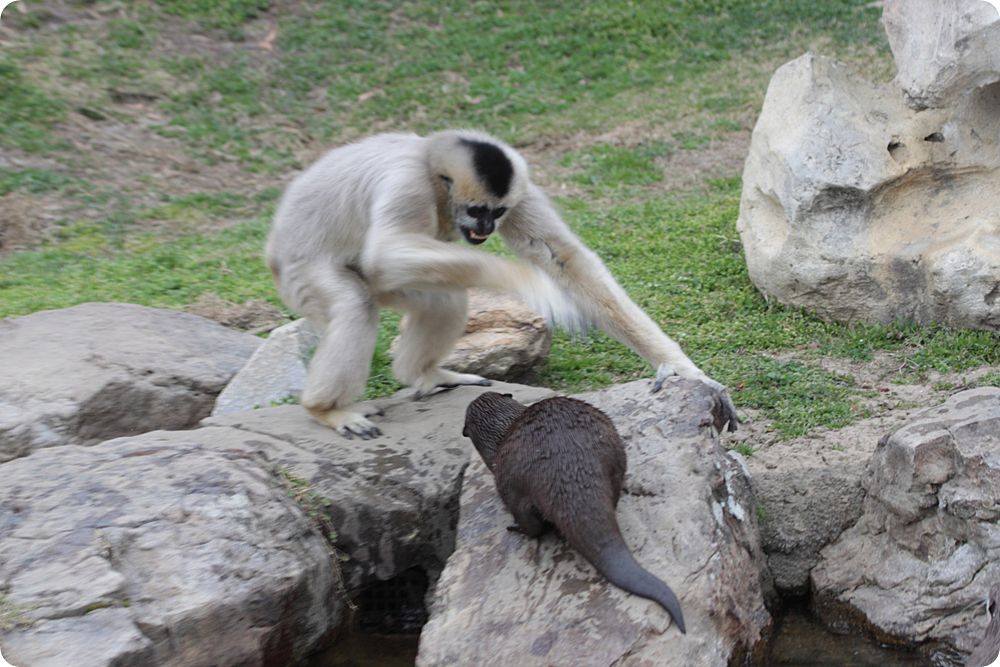
Asian Small-clawed Otter (Aonyx cinereus) and Northern White-cheeked Gibbon (Nomascus leucogenys)
Memphis Zoo, Tennessee, United States of America
Photo © Brent Huffman
Combined species:
- Asian Small-clawed Otter, Aonyx cinereus
- Northern White-cheeked Gibbon, Nomascus leucogenys
- Reeves’ Muntjac, Muntiacus reevesi
Institution(s): San Antonio Zoo (Texas, United States of America)
Combined species:
- Asian Small-clawed Otter, Aonyx cinereus
- Northern White-cheeked Gibbon, Nomascus leucogenys
- Lowland Anoa, Bubalus depressicornis
Institution(s): Point Defiance Zoo & Aquarium (Tacoma, Washington, United States of America)
Combined species:
- Asian Small-clawed Otter, Aonyx cinereus
- White-handed Gibbon, Hylobates lar
Institution(s): Brookfield Zoo (Illinois, United States of America), Omaha’s Henry Doorly Zoo and Aquarium (Nebraska, United States of America), Indianapolis Zoo (Indiana, United States of America), Parken Zoo (Eskilstuna, Sweden), Randers Regnskov (Denmark)
Combined species:
- Asian Small-clawed Otter, Aonyx cinereus
- Pileated Gibbon, Hylobates pileatus
Institution(s): Randers Regnskov (Denmark)
Combined species:
- Asian Small-clawed Otter, Aonyx cinereus
- Siamang, Symphalangus syndactylus
Institution(s): Marwell Zoo (Winchester, United Kingdom), Brookfield Zoo (Illinois, United States of America), Adelaide Zoo (South Australia, Australia)
Combined species:
- Asian Small-clawed Otter Aonyx cinereus
- Proboscis Monkey, Nasalis larvatus
Institution(s): Bronx Zoo (New York, United States of America)
Combined species:
- Asian Small-clawed Otter, Aonyx cinereus
- Sumatran Orangutan, Pongo abelii
Institution(s): Tierpark Hagenbeck (Hamburg, Germany), Zoo Dortmund (Germany), Pairi Daiza (Brugelette, Belgium), Zoo d'Amnéville (France)
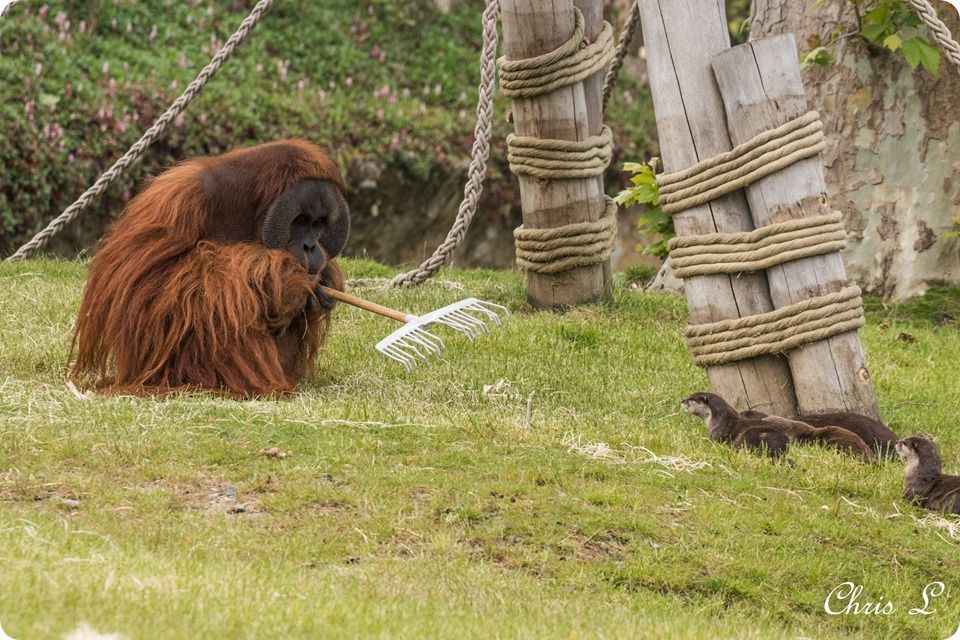
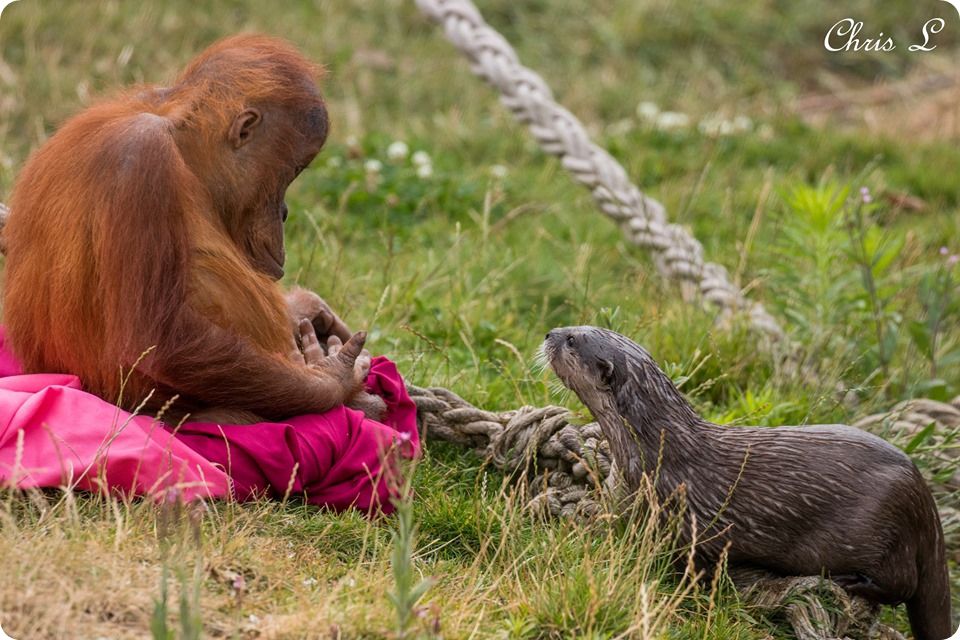
Asian Small-clawed Otter (Aonyx cinereus) and Sumatran Orangutan (Pongo abelii)
Pairi Daiza, Brugelette, Belgium
Photos © Christine Leroy
Combined species:
- Asian Small-clawed Otter, Aonyx cinereus
- Bornean Orangutan, Pongo pygmaeus
Institution(s): Allwetterzoo Münster (Germany), Bioparc Fuengirola (Spain)
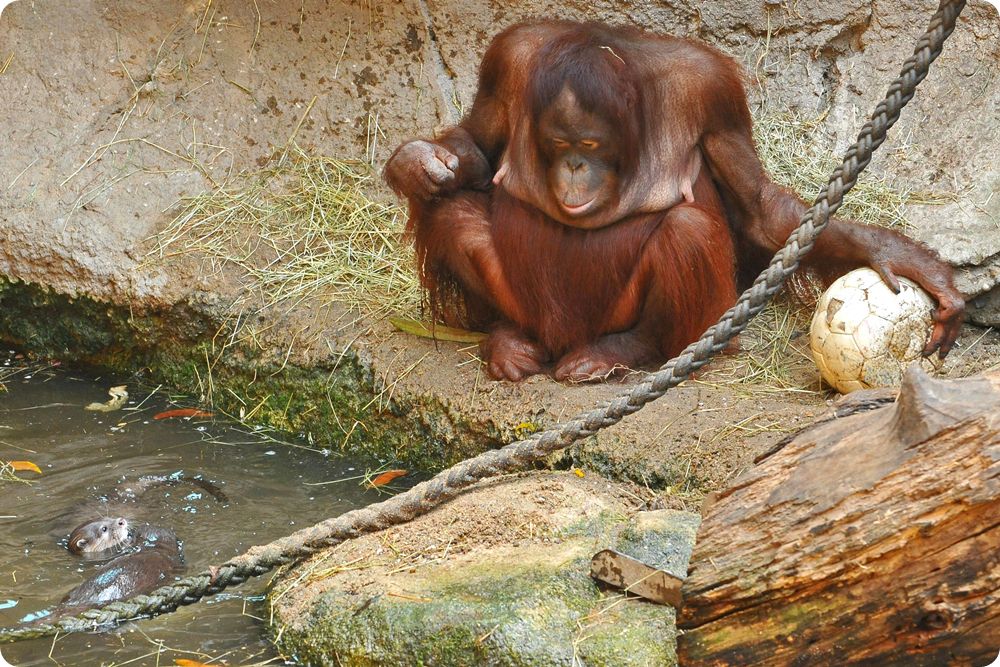
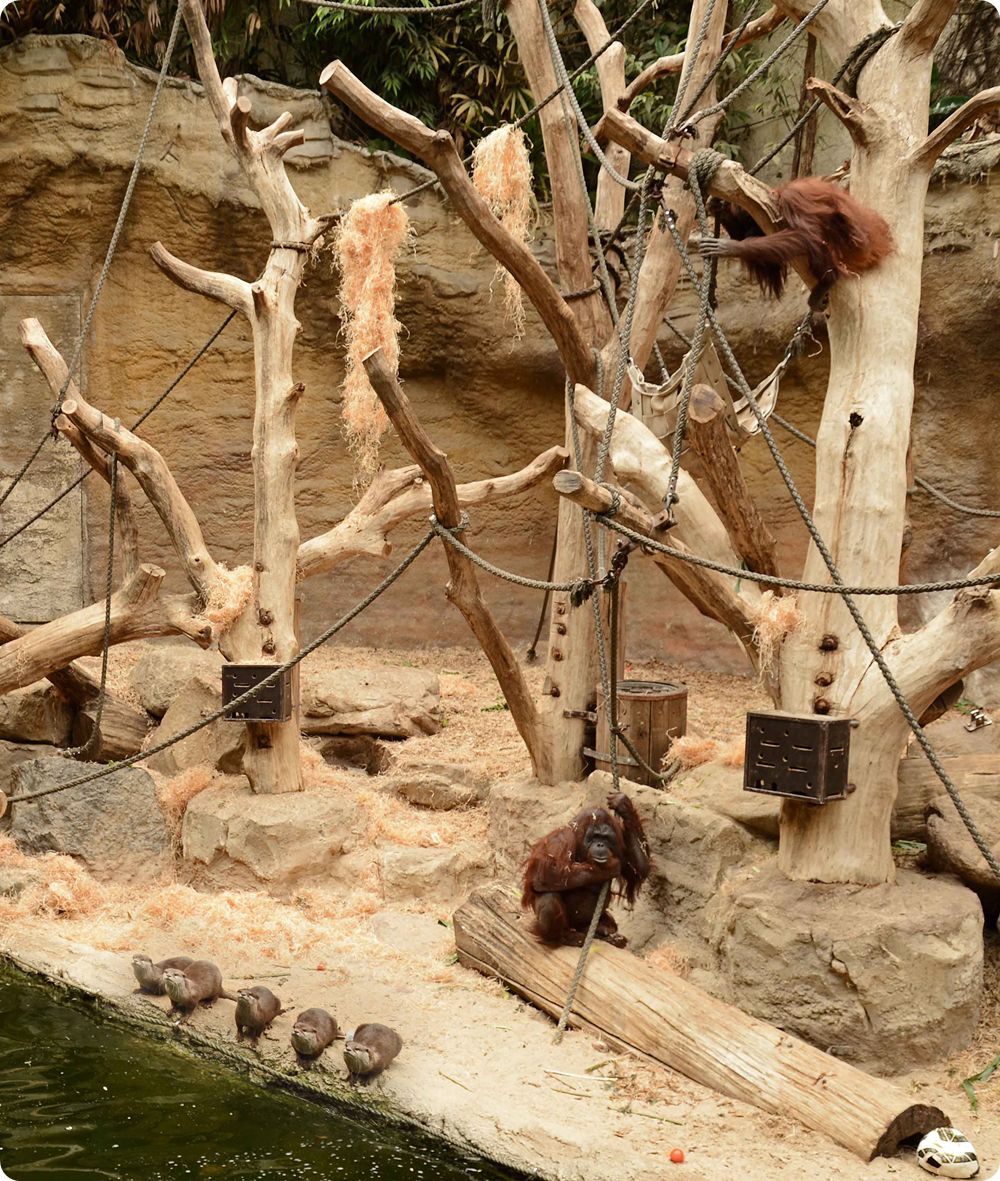
Asian Small-clawed Otters (Aonyx cinereus) and Bornean Orangutans (Pongo pygmaeus)
Allwetterzoo Münster, Germany
Photos © dr. Simone Schehka
Combined species:
- Asian Small-clawed Otter, Aonyx cinereus
- Sumatran Orangutan, Pongo abelii
- White-handed Gibbon, Hylobates lar
Institution(s): Chester Zoo (United Kingdom), Jersey Zoo (Trinity, Channel Islands), Zoo La Boissière du Doré (France), Fort Worth Zoo (Texas, United States of America)
Combined species:
- Asian Small-clawed Otter, Aonyx cinereus
- Bornean Orangutan, Pongo pygmaeus
- White-handed Gibbon, Hylobates lar
Institution(s): Chester Zoo (United Kingdom)
Combined species:
- Asian Small-clawed Otter, Aonyx cinereus
- Bornean Orangutan, Pongo pygmaeus
- Lion-tailed Macaque, Macaca silenus
- Black-hooded Oriole, Oriolus xanthornus
- Oriental Magpie-robin, Copsychus saularis
- Brahminy Starling, Temenuchus pagodarum
- Asian Fairy-bluebird, Irena puella
- Black-capped Bulbul, Pycnonotus melanicterus
- Golden-fronted Leafbird, Chloropsis aurifrons
- Pale-bellied White-eye, Zosterops consobrinorum
Institution(s): Allwetterzoo Münster (Germany)
Combined species:
- Asian Small-clawed Otter, Aonyx cinereus
- Prevost’s Squirrel, Callosciurus prevostii
Institution(s): Brookfield Zoo (Illinois, United States of America), Houston Zoo (Texas, United States of America), Lincoln Park Zoo (Chicago, Illinois, United States of America)
Combined species:
- Asian Small-clawed Otter, Aonyx cinereus
- Prevost’s Squirrel, Callosciurus prevostii
- Blue-bellied Roller, Coracias cyanogaster
Institution(s): Houston Zoo (Texas, United States of America)
Combined species:
- Asian Small-clawed Otter, Aonyx cinereus
- Indian Crested Porcupine, Hystrix indica
Institution(s): Point Defiance Zoo & Aquarium (Tacoma, Washington, United States of America), Newport Aquarium (Kentucky, United States of America)
Combined species:
- Asian Small-clawed Otter, Aonyx cinereus
- Black Giant Squirrel, Ratufa bicolor
Institution(s): Brookfield Zoo (Illinois, United States of America), Lincoln Park Zoo (Chicago, Illinois, United States of America)
Combined species:
- Asian Small-clawed Otter, Aonyx cinereus
- Black Giant Squirrel, Ratufa bicolor
- Lesse Dog-faced Fruit Bat, Cynopterus brachyotis
- Island Flying Fox, Pteropus hypomelanus
- Lesser Oriental Chevrotain, Tragulus kanchil
- Green-backed Heron, Butorides striata
- Green Peafowl, Pavo muticus
- Black-naped Oriole, Oriolus chinensis
- Blue-winged Pitta, Pitta moluccensis
- Leafbird, Chloropsis sp.
- Common Hill Myna, Gracula religiosa
- Northern River Terrapin, Batagur baska
- Tilapia, Oreochromis sp.
Institution(s): Zoo Taiping & Night Safari (Malaysia)
Combined species:
- Asian Small-clawed Otter, Aonyx cinereus
- Rodrigues Flying Fox, Pteropus rodricensis
unknown institution
Combined species:
- Asian Small-clawed Otter, Aonyx cinereus
- Asiatic Lion, Panthera leo persica
Institution(s): Zoo Zürich (Switzerland)
Combined species:
- Asian Small-clawed Otter Aonyx cinereus
- Binturong, Arctictis binturong
Institution(s): Zoologická zahrada hl. m. Prahy (Czech Republic), Zoologická zahrada Ostrava (Czech Republic), Hamerton Zoo Park (Huntingdon, United Kingdom), Colchester Zoo (United Kingdom), Longleat (Warminster, United Kingdom), Zoo de Lille (France), Zoo Vivarium Darmstadt (Germany), Zoo Heidelberg (Germany), Parco Faunistico La Torbiera (Agrate Conturbia, Italy), ZooParc Overloon (the Netherlands), Singapore Zoo - Wildlife Reserves Singapore (Singapore), Night Safari - Wildlife Reserves Singapore (Singapore), Khao Kheow Open Zoo (Si Racha, Thailand), Melbourne Zoo (Victoria, Australia), Loveland Living Planet Aquarium (Draper, Utah, United States of America)
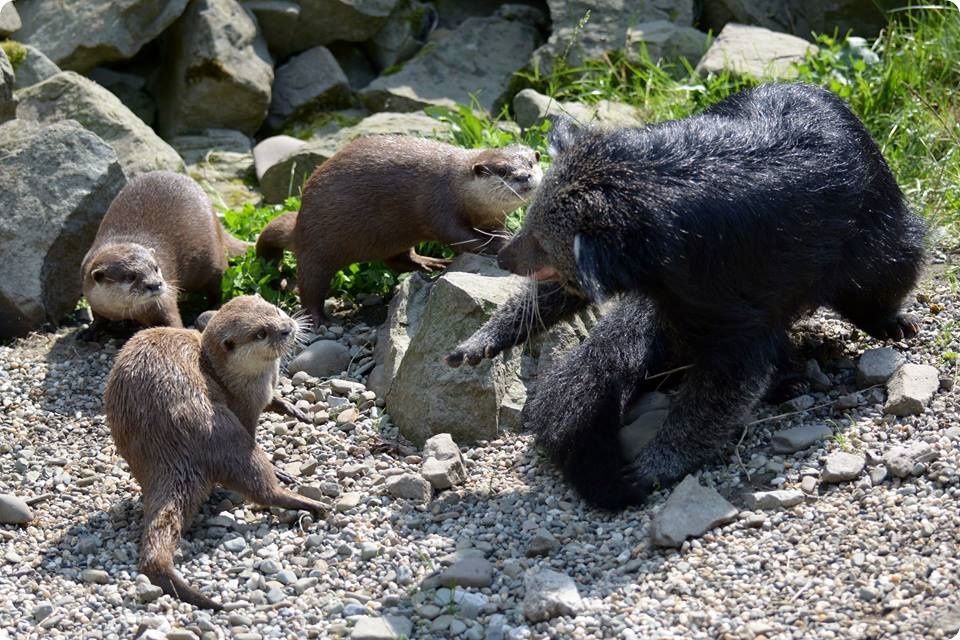
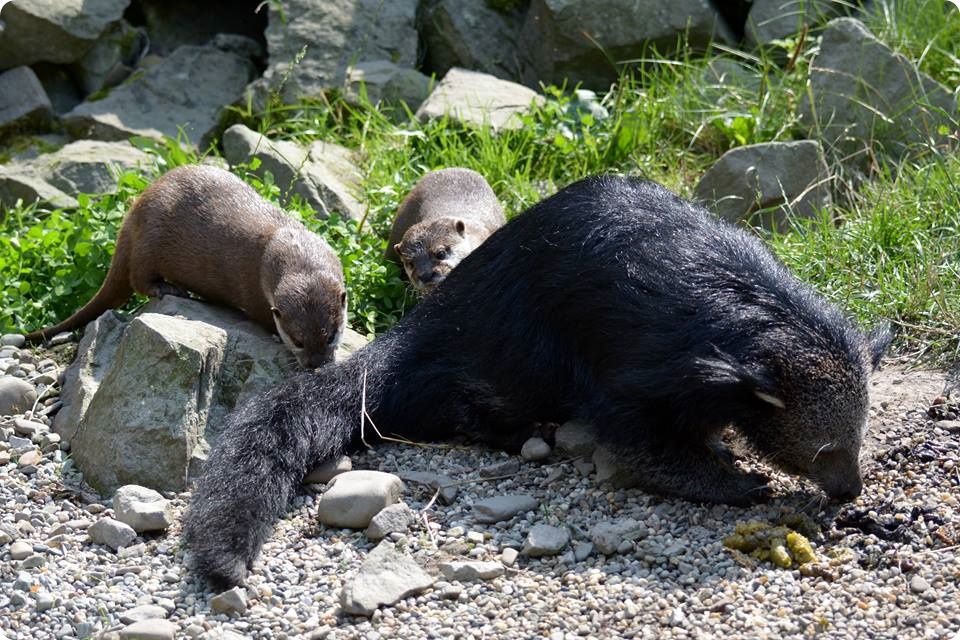
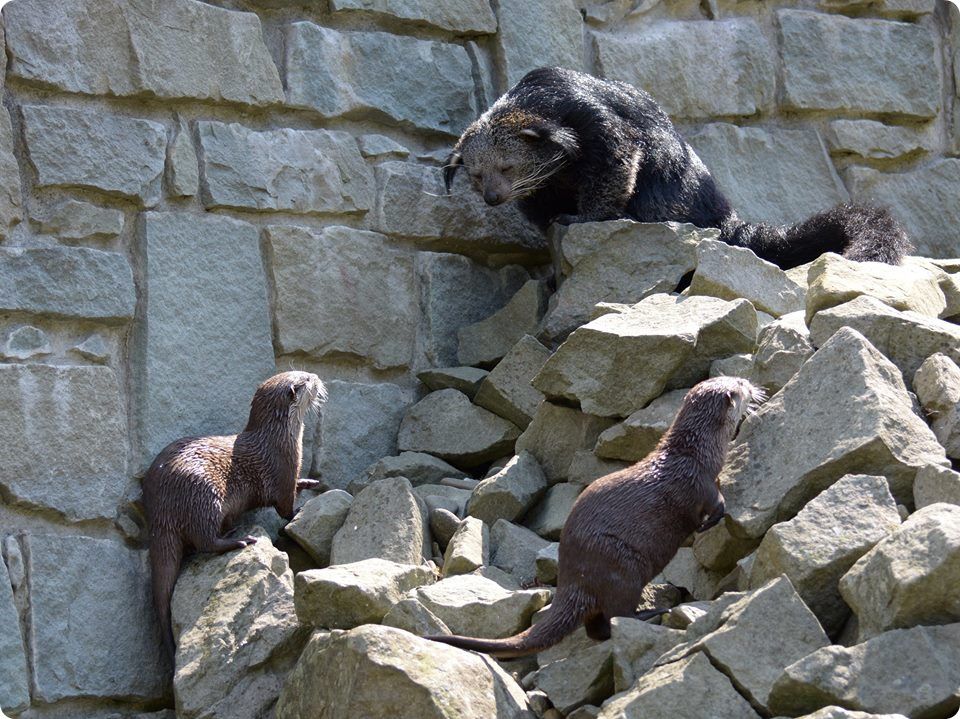
Asian Small-clawed Otters (Aonyx cinereus) and Binturong (Arctictis binturong)
Zoologická zahrada Ostrava, Czech Republic
Photo © Tamás Boros
Asian Small-clawed Otters (Aonyx cinereus) and Binturongs (Arctictis binturong)
Zoologická zahrada Ostrava, Czech Republic
Photo © Krisztián Svábik
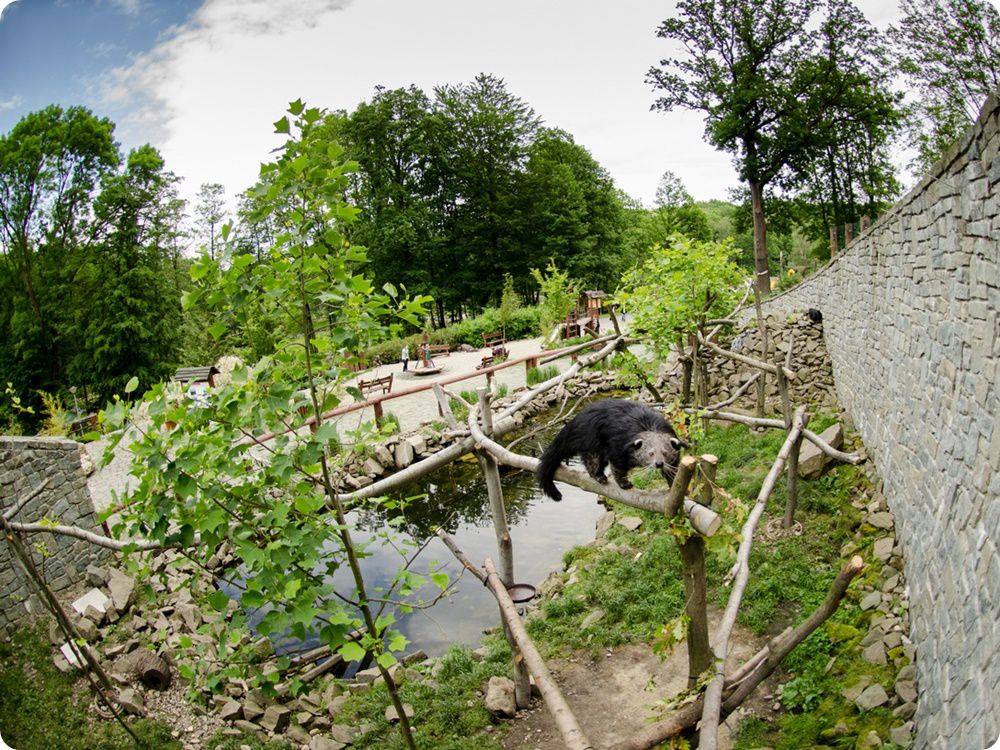
Asian Small-clawed Otter (Aonyx cinereus) and Binturong (Arctictis binturong) mixed exhibit
Zoologická zahrada Ostrava, Czech Republic
Photo © Pavel Vlček
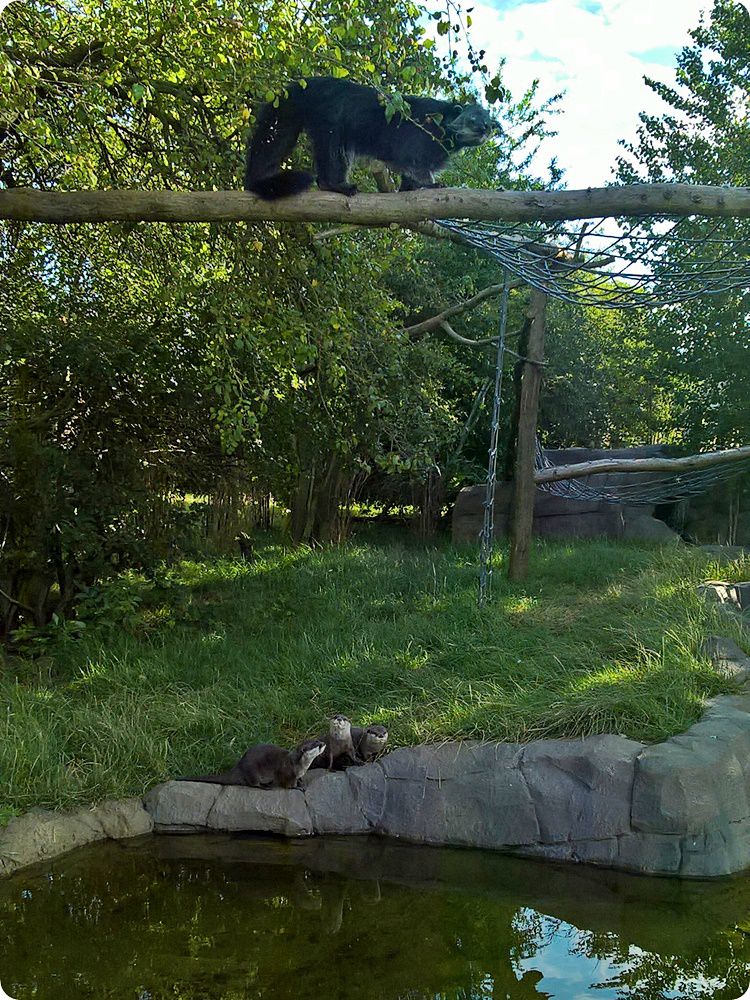
Asian Small-clawed Otters (Aonyx cinereus) and Binturong (Arctictis binturong)
Hamerton Zoo Park, Huntingdon, United Kingdom
Photo © Amy Beardmore
Combined species:
- Asian Small-clawed Otter, Aonyx cinereus
- Binturong, Arctictis binturong
- Prevost’s Squirrel, Callosciurus prevostii
Institution(s): Brookfield Zoo (Illinois, United States of America)
Combined species:
- Asian Small-clawed Otter, Aonyx cinereus
- Binturong, Arctictis binturong
- Common Palm Civet, Paradoxurus hermaphroditus
Institution(s): Wild Zoological Park (Bobbington, United Kingdom)
Combined species:
- Asian Small-clawed Otter, Aonyx cinereus
- Binturong, Arctictis binturong
- Reeves’ Muntjac, Muntiacus reevesi
Institution(s): AquaZoo Friesland (Leeuwarden, the Netherlands)
Combined species:
- Asian Small-clawed Otter Aonyx cinereus
- Binturong, Arctictis binturong
- Common Water Monitor, Varanus salvator
Institution(s): Singapore Zoo - Wildlife Reserves Singapore (Singapore)
Combined species:
- Asian Small-clawed Otter, Aonyx cinereus
- Corsac Fox, Vulpes corsac
- Sloth Bear, Melurus ursinus
Institution(s): Safaripark Beekse Bergen (Hilvarenbeek, the Netherlands)
Combined species:
- Asian Small-clawed Otter, Aonyx cinereus
- Western Red Panda, Ailurus fulgens fulgens
Institution(s): Welsh Mountain Zoo (Colwyn Bay, United Kingdom), ZooParc Overloon (the Netherlands), AquaZoo Friesland (Leeuwarden, the Netherlands)
Asian Small-clawed Otter (Aonyx cinereus) and Western Red Panda (Ailurus fulgens fulgens) mixed exhibit
Welsh Mountain Zoo, Colwyn Bay, United Kingdom
Photo © Ben Gilbert
Combined species:
- Asian Small-clawed Otter, Aonyx cinereus
- Western Red Panda, Ailurus fulgens fulgens
- Reeves’ Muntjac, Muntiacus reevesi
Institution(s): Parc Zoologique et Botanique de Mulhouse (France)
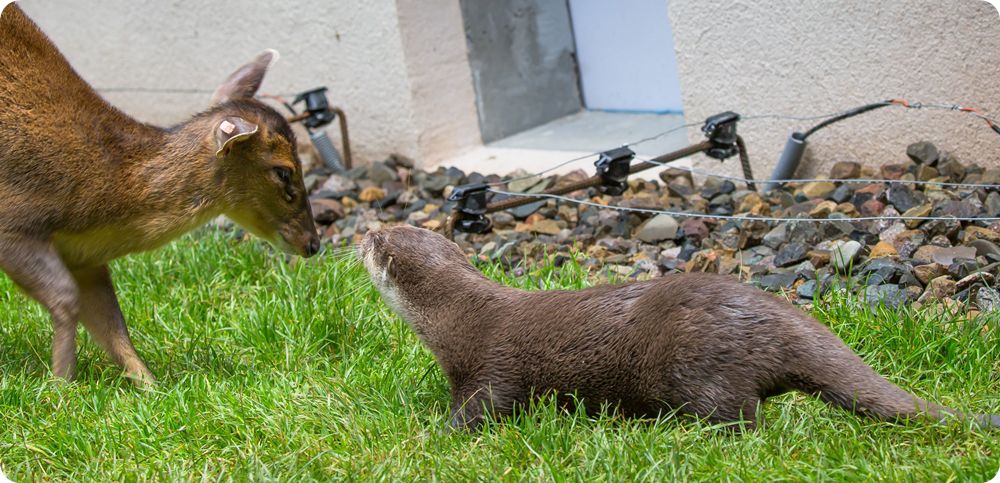
Asian Small-clawed Otter (Aonyx cinereus) and Reeves' Muntjac (Muntiacus reevesi)
Parc Zoologique et Botanique de Mulhouse, France
Photo © Dominique Villiseck
Combined species:
- Asian Small-clawed Otter, Aonyx cinereus
- Western Red Panda, Ailurus fulgens fulgens
- Southern Cassowary, Casuarius casuarius
Institution(s): Bioparc Fuengirola (Spain)
Combined species:
- Asian Small-clawed Otter, Aonyx cinereus
- Northern Raccoon, Procyon lotor
Institution(s): Aachener Tierpark Euregiozoo (Germany)
Combined species:
- Asian Small-clawed Otter, Aonyx cinereus
- South American Coati, Nasua nasua
Institution(s): Apenheul (Apeldoorn, the Netherlands)
Combined species:
- Asian Small-clawed Otter, Aonyx cinereus
- Malayan tapir, Tapirus indicus
Institution(s): Point Defiance Zoo & Aquarium (Tacoma, Washington, United States of America)
Combined species:
- Asian Small-clawed Otter, Aonyx cinereus
- Greater One-horned Rhinoceros, Rhinoceros unicornis
- Reeves’ Muntjac, Muntiacus reevesi
Institution(s): Zoo Basel (Switzerland)
Combined species:
- Asian Small-clawed Otter, Aonyx cinereus
- Greater One-horned Rhinoceros, Rhinoceros unicornis
- Visayan Warty Pig, Sus cebifrons negrinus
- Reeves’ Muntjac, Muntiacus reevesi
Institution(s): Zoo Basel (Switzerland)
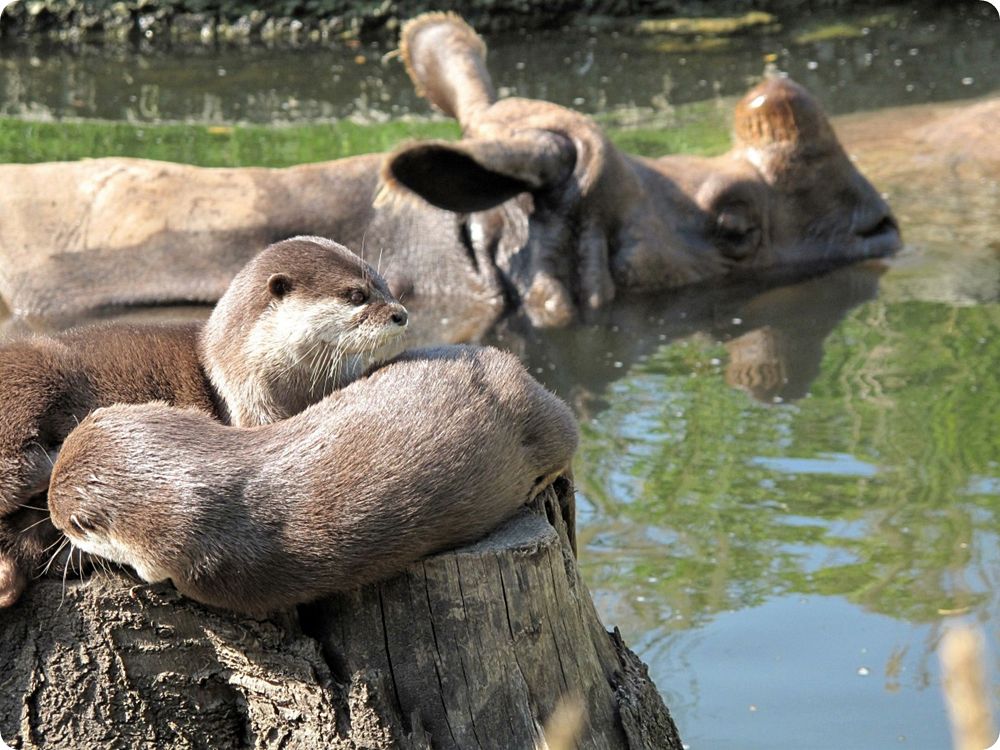
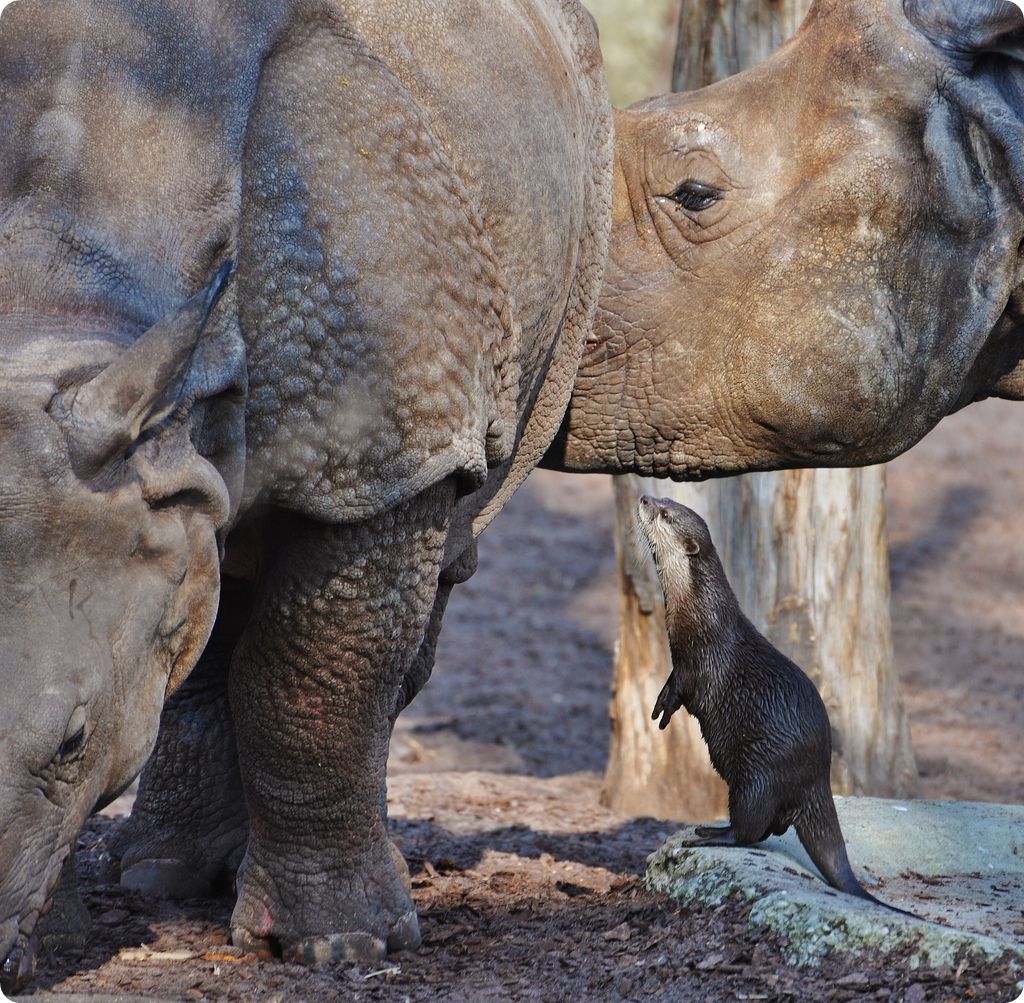
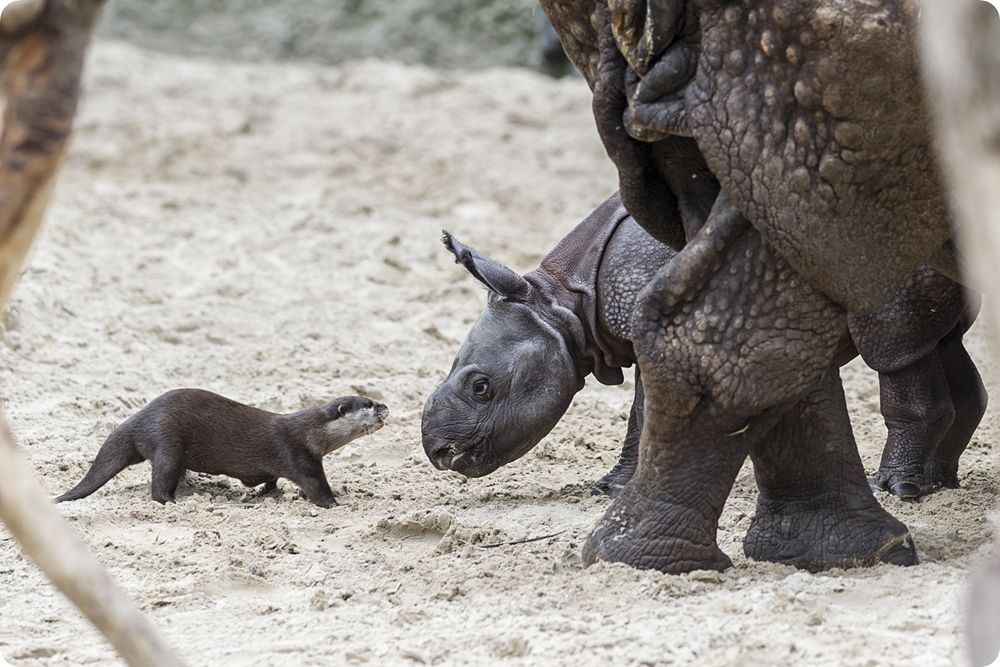
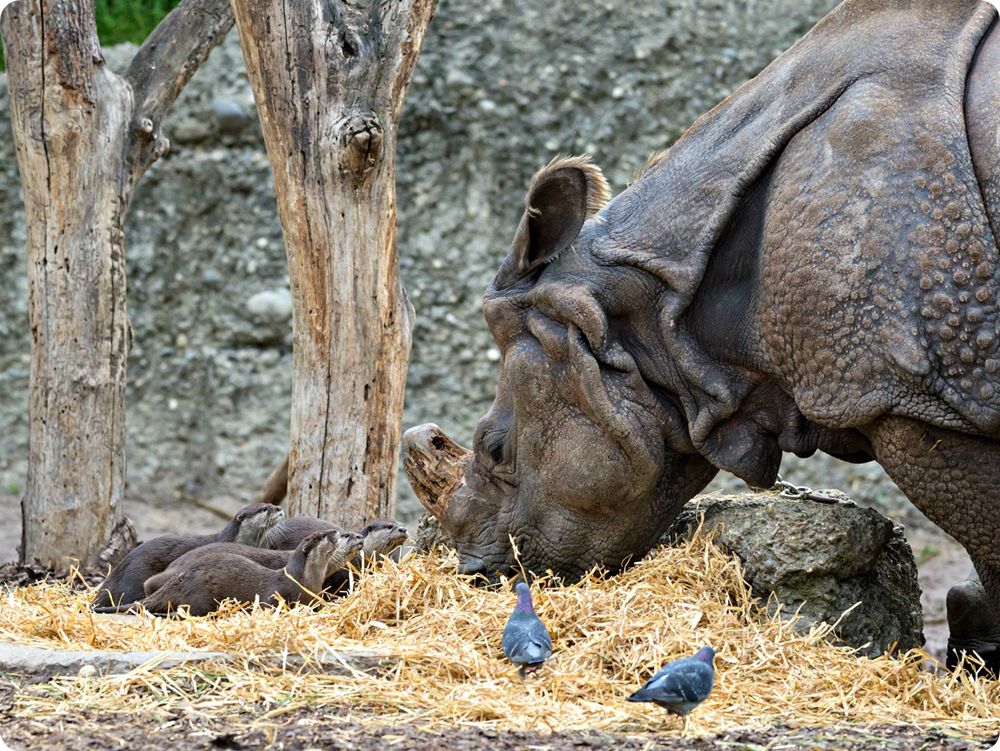
Asian Small-clawed Otters (Aonyx cinereus) and Greater One-horned Rhinoceroses (Rhinoceros unicornis)
Zoo Basel, Switzerland
Photos © Zoo Basel
Asian Small-clawed Otter (Aonyx cinereus) and Greater One-horned Rhinoceros (Rhinoceros unicornis)
Zoo Basel, Switzerland
Photo © Wikimedia Commons
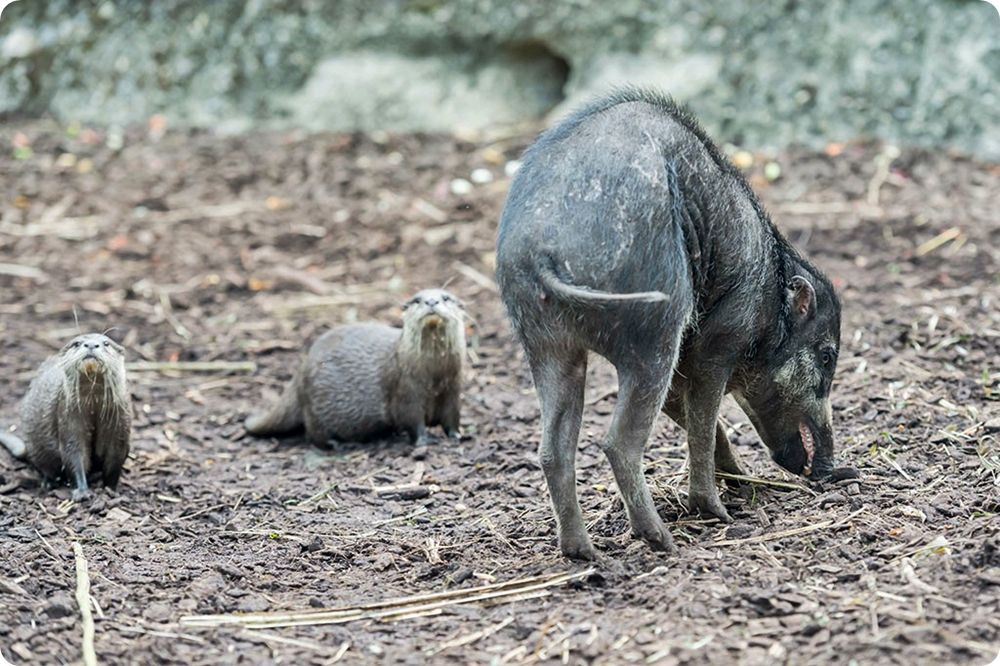
Asian Small-clawed Otters (Aonyx cinereus) and Visayan Warty Pig (Sus cebifrons negrinus)
Zoo Basel, Switzerland
Photo © Zoo Basel
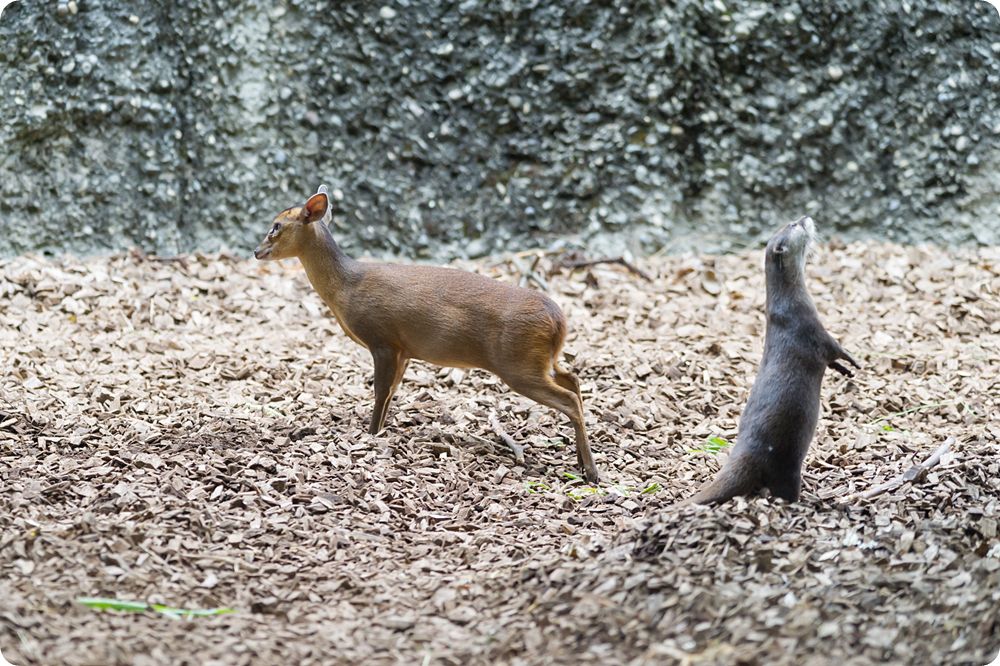
Asian Small-clawed Otter (Aonyx cinereus) and Reeves' Muntjac (Muntiacus reevesi)
Zoo Basel, Switzerland
Photo © Zoo Basel
Asian Small-clawed Otters (Aonyx cinereus) and Reeves' Muntjac (Muntiacus reevesi)
Zoo Basel, Switzerland
Photo © Krisztián Svábik
Combined species:
- Asian Small-clawed Otter, Aonyx cinereus
- Sulawesi Babirusa, Babyrousa celebensis
Institution(s): Audubon Nature Institute (New Orleans, Louisiana, United States of America), Jacksonville Zoo and Gardens (Florida, United States of America), Chester Zoo (United Kingdom)
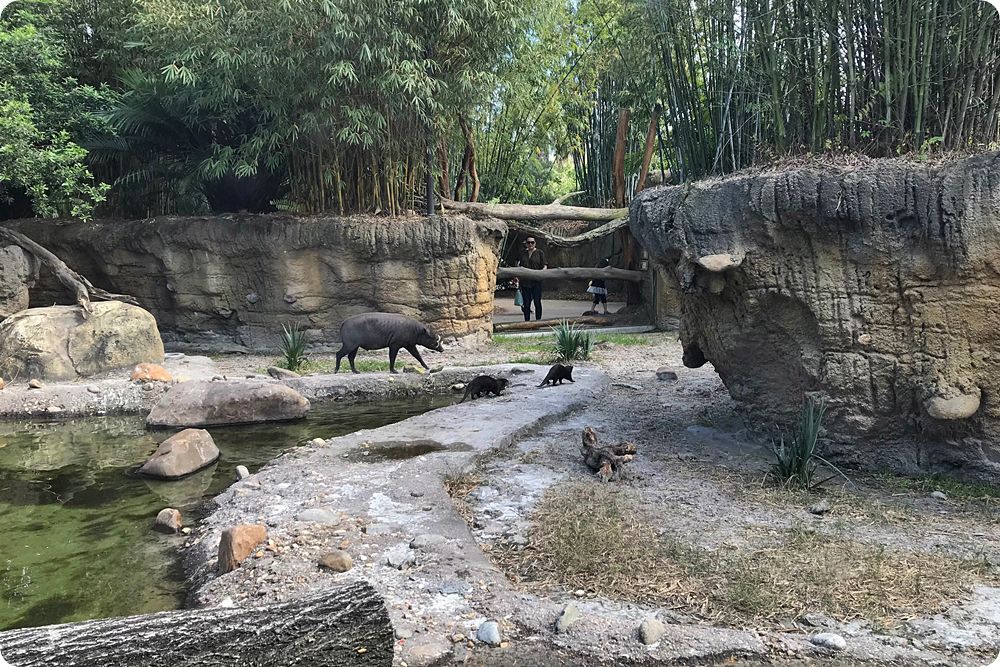
Asian Small-clawed Otters (Aonyx cinereus) and Sulawesi Babirusa (Babyrousa babyrussa)
Jacksonville Zoo and Gardens, Florida, United States of America
Photo © Curby Simerson
Asian Small-clawed Otters (Aonyx cinereus) and Sulawesi Babirusa (Babyrousa babyrussa)
Jacksonville Zoo and Gardens, Florida, United States of America
Photo © Fred Hood
Asian Small-clawed Otters (Aonyx cinereus) and Sulawesi Babirusa (Babyrousa babyrussa)
Chester Zoo, United Kingdom
Photo © Christopher Holland
Combined species:
- Asian Small-clawed Otter, Aonyx cinereus
- Reeves’ Muntjac, Muntiacus reevesi
Institution(s): Zoo Atlanta (Georgia, United States of America)
Combined species:
- Asian Small-clawed Otter, Aonyx cinereus
- Lowland Anoa, Bubalus depressicornis
Institution(s): Point Defiance Zoo & Aquarium (Tacoma, Washington, United States of America)
Combined species:
- Asian Small-clawed Otter, Aonyx cinereus
- Greater Hornbill, Buceros bicornis
unknown institution
Combined species:
- Asian Small-clawed Otter, Aonyx cinereus
- Black Hornbill, Anthracoceros malayanus
unkown institution
Combined species:
- Asian Small-clawed Otter, Aonyx cinereus
- Slender-snouted Crocodile, Mecistops cataphractus
unknown institution
Combined species:
- Asian Small-clawed Otter, Aonyx cinereus
- Giant Pangasius, Pangasius sanitwongsei
- Red-bellied Pacu, Piaractus brachypomus
- Hemiodus sp.
- Leporinus sp.
Institution(s): Disney’s Animal Kingdom Theme Park (Orlando, Florida, United States of America)
Combined species:
- Asian Small-clawed Otter, Aonyx cinereus
- Butterflies, Lepidoptera
unknown institution
African Clawless Otter, Aonyx capensis
Combined species:
- African Clawless Otter, Aonyx capensis
- Guenon, Cercopithecus sp.
unkown institution
Combined species:
- African Clawless Otter, Aonyx capensis
- De Brazza’s Monkey, Cercopithecus neglectus
unknown institution
Giant Otter, Pteronura brasiliensis
Combined species:
- Giant Otter, Pteronura brasiliensis
- White-faced Saki, Pithecia pithecia
Institution(s): Aquazoo Friesland (Leeuwarden, the Netherlands)
Combined species:
- Giant Otter, Pteronura brasiliensis
- Silvery Marmoset, Mico argentatus
- White-faced Saki, Pithecia pithecia
Institution(s): Zoo Leipzig (Germany)
Combined species:
- Giant Otter, Pteronura brasiliensis
- Spider Monkey, Ateles sp.
- Capybara, Hydrochoerus hydrochaeris
- South American Tapir, Tapirus terrestris
Institution(s): Zoológico da UFMT (Cuiabá, Mato Grosso, Brazil)
Combined species:
- Giant Otter, Pteronura brasiliensis
- Caiman, Caiman sp.
unknown institution
 See Otter, Enhydra lutris
See Otter, Enhydra lutris
Combined species:
- See Otter, Enhydra lutris
- Harbor Seal, Phoca vitulina
Institution(s): Franklin Park Zoo (Boston, Massachusetts, United States of America)
European Badger, Meles meles
Combined species:
- European Badger, Meles meles
- Red Fox, Vulpes vulpes
Institution(s): Natur- und Tierpark Goldau (Switzerland), Zoo am Meer Bremerhaven (Germany)
Combined species:
- European Badger, Meles meles
- European Pine Marten, Martes martes
Institution(s): Alpenzoo Innsbruck (Austria)
Combined species:
- European Badger, Meles meles
- Common Raven, Corvus corax
Institution(s): Miskolci Állatkert és Kultúrpark (Hungary)
Hog Badger, Arctonyx collaris
Combined species:
- Hog Badger, Arctonyx collaris
- Binturong, Arctictis binturong
- Masked Palm Civet, Paguma larvata
Institution(s): Shanghai Zoo (China)
Combined species:
- Hog Badger, Arctonyx collaris
- Masked Palm Civet, Paguma larvata
- Northern Raccoon, Procyon lotor
- Striped Skunk, Mephitis mephitis
Institution(s): Shanghai Zoo (China)
Large-toothed Ferret-badger, Melogale personata
Combined species:
- Large-toothed Ferret-badger, Melogale personata
- Common Palm Civet, Paradoxurus hermaphroditus
Institution(s): Yadanabon Zoological Gardens (Mandalay, Myanmar)
 American Badger, Taxidea taxus
American Badger, Taxidea taxus
Combined species:
- American Badger, Taxidea taxus
- Northern Raccoon, Procyon lotor
Institution(s): Los Angeles Zoo (California, United States of America)
LIST OF MIXED-SPECIES EXHIBITS WITH LOCATIONS - MEPHITIDAE
The list shows specific examples of mixed-species exhibits involving at least one skunk species combined with the taxa below, with indication of the institution(s) where they have been tried out
Striped Skunk, Mephitis mephitis
Combined species:
- Striped Skunk, Mephitis mephitis
- Southern Hairy-nosed Wombat, Lasiorhinus latifrons
- Southern Three-banded Armadillo, Tolypeutes matacus
- Garnett’s Greater Galago, Otolemur garnettii
- Agouti, Dasyprocta sp.
Institution(s): Memphis Zoo (Tennessee, United States of America)
Combined species:
- Striped Skunk, Mephitis mephitis
- Northern Tree Shrew, Tupaia belangeri
Institution(s): Yekaterinburgskiy Zoopark (Jekatyerinburg, Russia)
Combined species:
- Striped Skunk, Mephitis mephitis
- Black-and-white Ruffed Lemur, Varecia variegata
Institution(s): Spaycific’ Zoo (Spay, France)
Combined species:
- Striped Skunk, Mephitis mephitis
- Nancy Ma’s Night Monkey, Aotus nancymaae
Institution(s): Faunia (Madrid, Spain)
Combined species:
- Striped Skunk, Mephitis mephitis
- Eurasian Red Squirrel, Sciurus vulgaris
Institution(s): Tropical Wings Zoo (South Woodham Ferrers, United Kingdom)
Combined species:
- Striped Skunk, Mephitis mephitis
- American Red Squirrel, Tamiasciurus hudsonicus
Institution(s): Lo Zoo di Napoli (Naples, Italy)
Combined species:
- Striped Skunk, Mephitis mephitis
- Southern Flying Squirrel, Glaucomys volans
Institution(s): Zoologischer Garten Berlin (Germany)
Combined species:
- Striped Skunk, Mephitis mephitis
- Black-tailed Prairie Dog, Cynomys ludovicianus
Institution(s): Ree Park Safari (Ebeltoft, Denmark), Folly Farm Adventure Park and Zoo (Kilgetty, United Kingdom)
Combined species:
- Striped Skunk, Mephitis mephitis
- Woodchuck, Marmota monax
Institution(s): Brookfield Zoo (Illinois, United States of America)
Combined species:
- Striped Skunk, Mephitis mephitis
- Crested Porcupine, Hystrix sp.
unknown institution
Combined species:
- Striped Skunk, Mephitis mephitis
- North American Porcupine, Erethizon dorsatum
Institution(s): Ree Park Safari (Ebeltoft, Denmark), ZOOM Erlebniswelt (Gelsenkirchen, Germany), Zoo Braunschweig „Arche Noah” (Germany), Exotic Zoo (Priorslee, United Kingdom), Turtle Bay Exploration Park (Redding, California, United States of America), Los Angeles Zoo (California, United States of America)
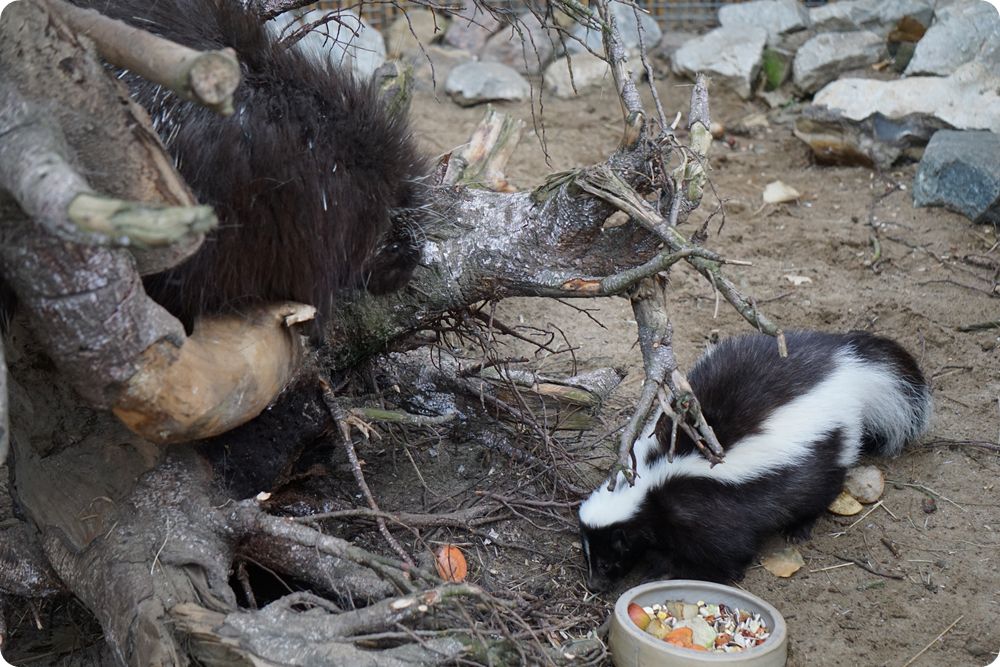
Striped Skunk (Mephitis mephitis) and North American Porcupine (Erethizon dorsatum)
Zoo Braunschweig „Arche Noah”, Germany
Photo © Zoo Braunschweig „Arche Noah”
Combined species:
- Striped Skunk, Mephitis mephitis
- Northern Raccoon, Procyon lotor
Institution(s): AquaZoo Friesland (Leeuwarden, the Netherlands), Dierenrijk (Mierlo, the Netherlands), GaiaZOO (Kerkrade, the Netherlands), ARTIS Amsterdam Royal Zoo (the Netherlands), ZOO Antwerpen (Belgium), Zoo Braunschweig „Arche Noah” (Germany), Zoo Stralsund (Germany), Heythrop Zoological Gardens (Chipping Norton, United Kingdom), Tayto Park (Ashbourne, Ireland), Kecskeméti Vadaskert (Hungary), Bronx Zoo (New York, New York, United States of America)
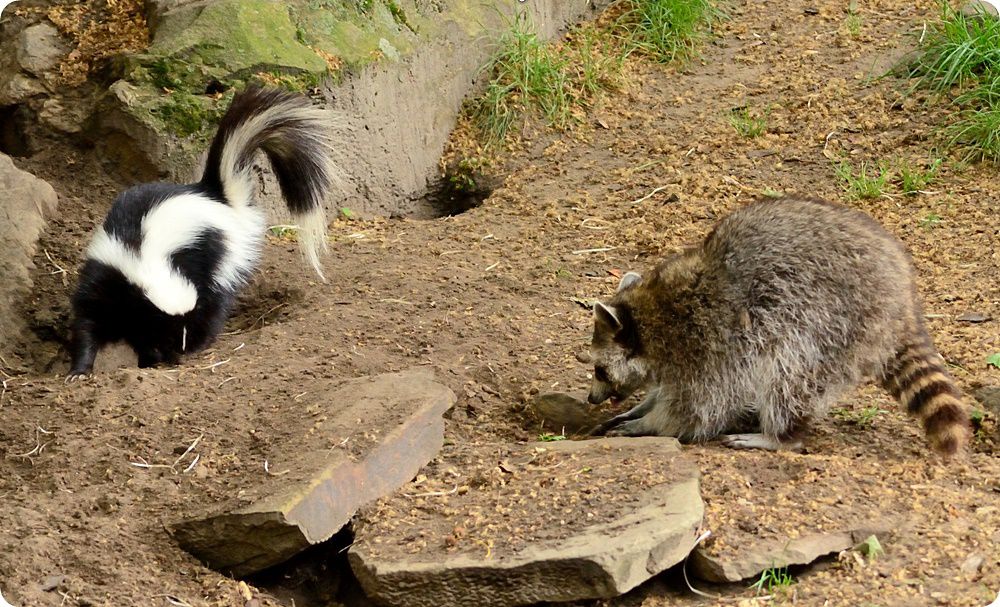
Striped Skunk (Mephitis mephitis) and Northern Raccoon (Procyon lotor)
ZOO Antwerpen, Belgium
Photo © Tom Van Deuren
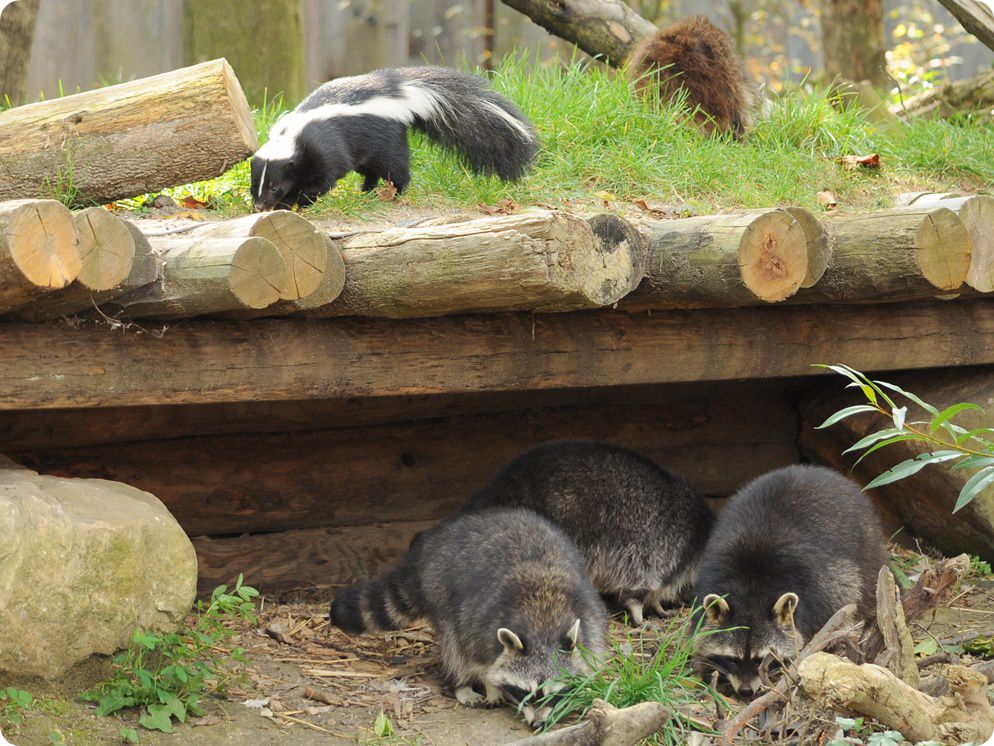
Striped Skunk (Mephitis mephitis) and Northern Raccoons (Procyon lotor)
GaiaZOO, Kerkrade, the Netherlands
Photo © GaiaZOO
Striped Skunks (Mephitis mephitis) and Northern Raccoons (Procyon lotor)
GaiaZOO, Kerkrade, the Netherlands
Photo © Örs Görög
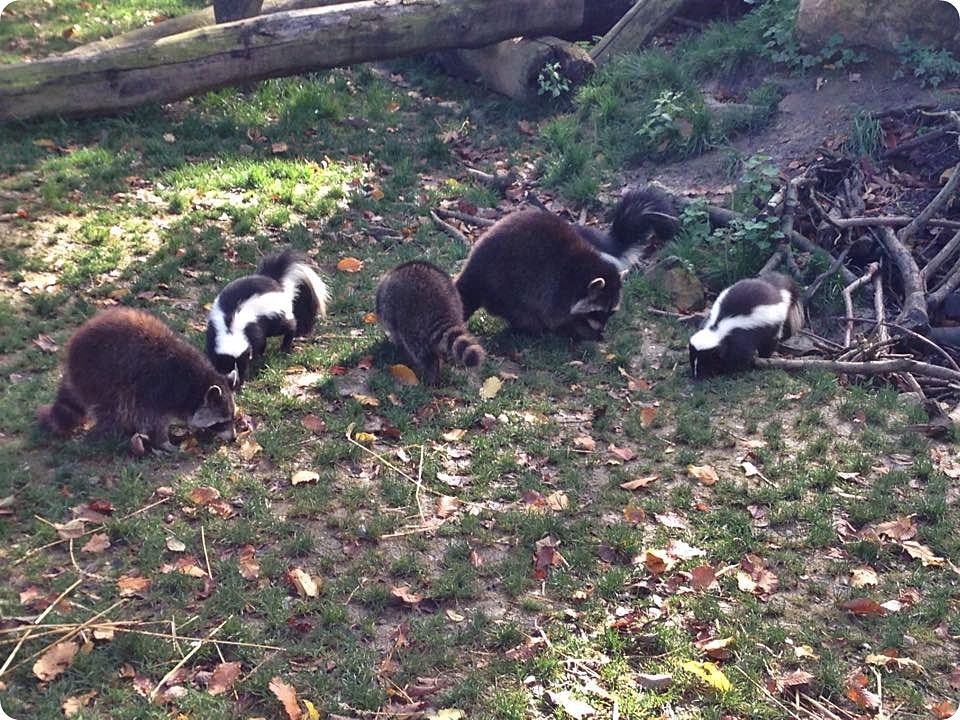
Striped Skunks (Mephitis mephitis) and Northern Raccoons (Procyon lotor)
GaiaZOO, Kerkrade, the Netherlands
Photo © Mario Berndtgen
Striped Skunk (Mephitis mephitis) and Northern Raccoon (Procyon lotor)
Heythrop Zoological Gardens, Chipping Norton, United Kingdom
Photo © Paul Irven
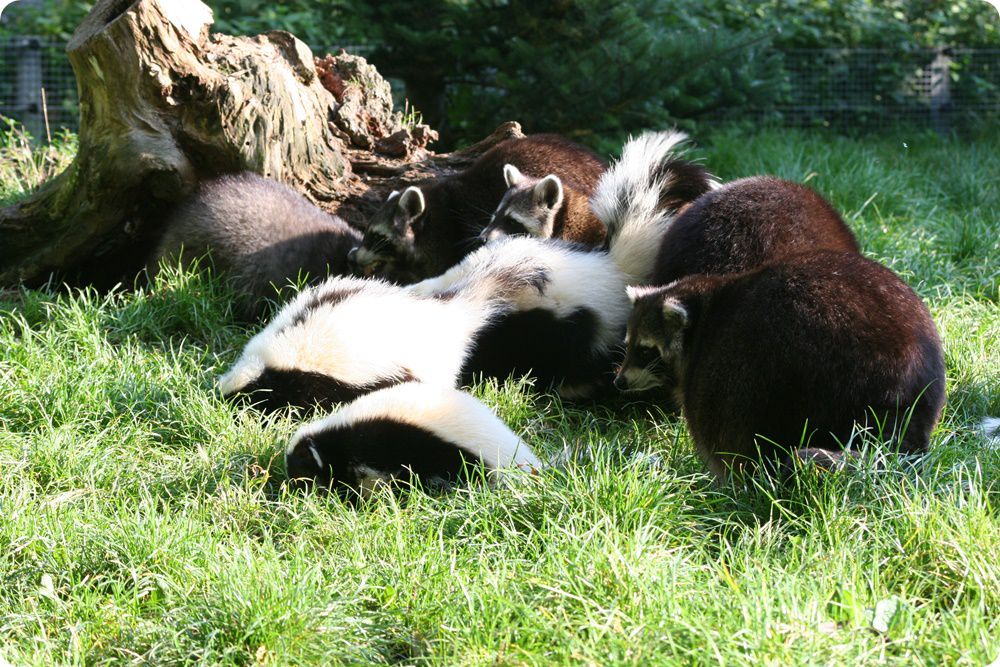
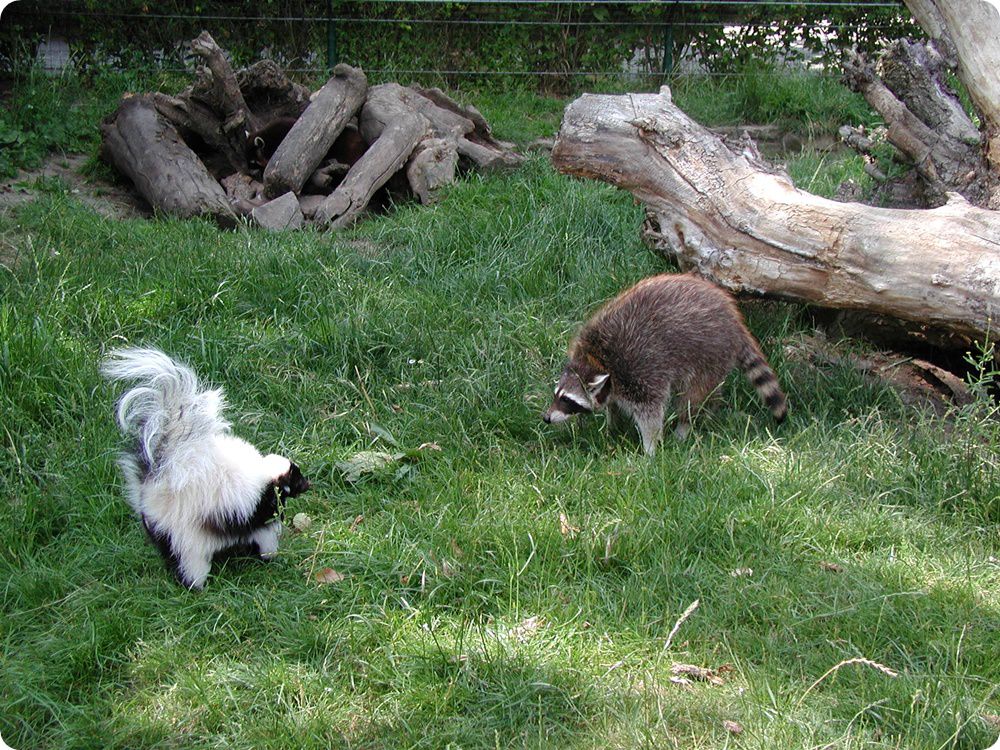
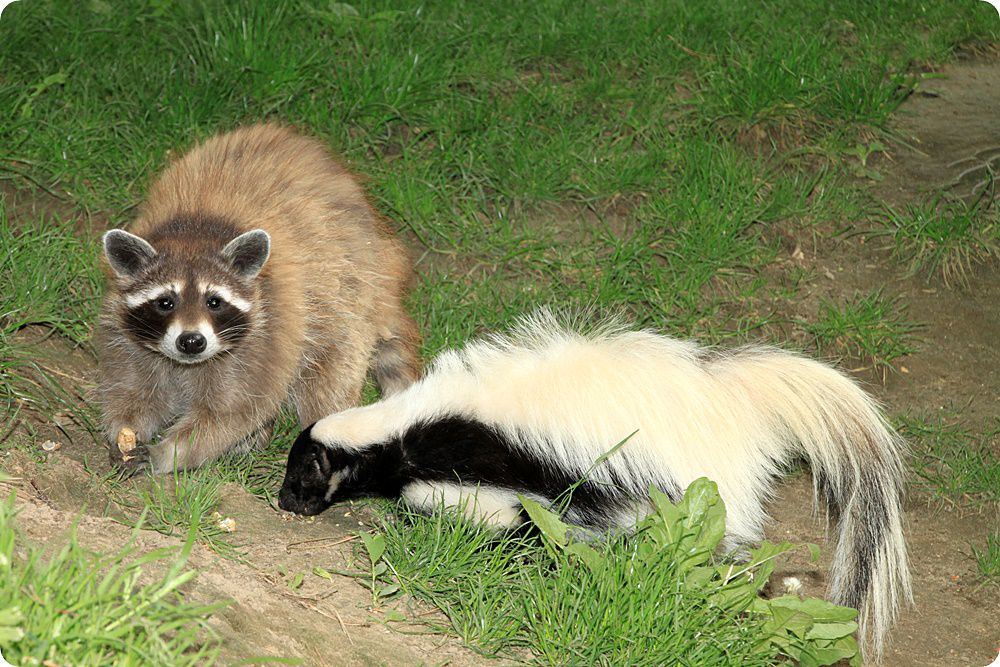
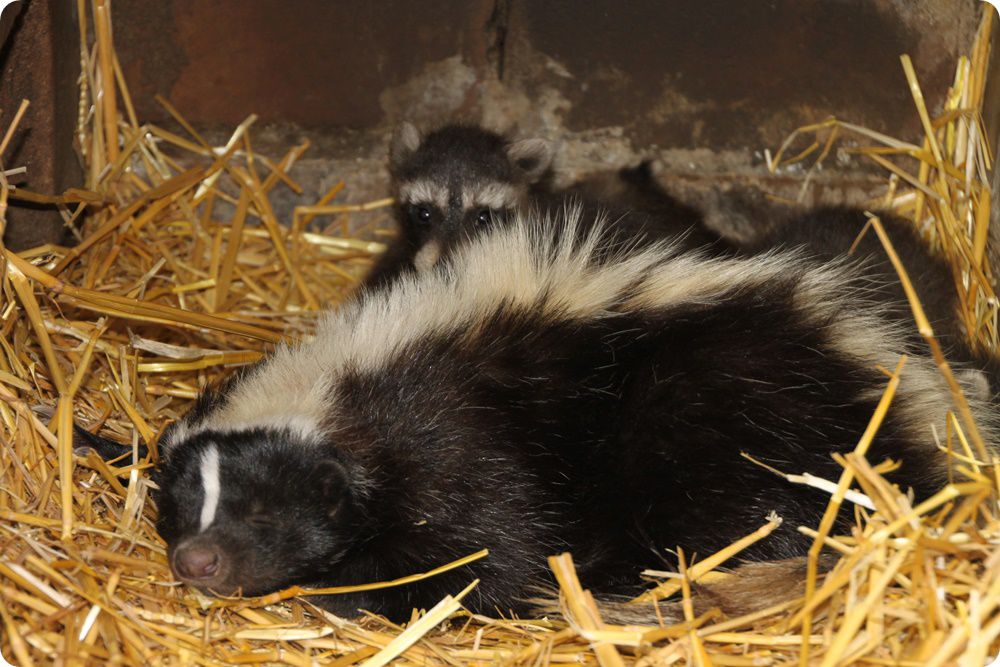
Striped Skunks (Mephitis mephitis) and Northern Raccoons (Procyon lotor)
Zoo Braunschweig „Arche Noah”, Germany
Photos © Zoo Braunschweig „Arche Noah”
Combined species:
- Striped Skunk, Mephitis mephitis
- Northern Raccoon, Procyon lotor
- Opossum, Didelphis sp.
unknown institution
Combined species:
- Striped Skunk, Mephitis mephitis
- Northern Raccoon, Procyon lotor
- Woodchuck, Marmota monax
unknown institution
Combined species:
- Striped Skunk, Mephitis mephitis
- Red Fox, Vulpes vulpes
- Northern Raccoon, Procyon lotor
- Eurasian Otter, Lutra lutra
Institution(s): Zoo sauvage de Saint-Félicien (Quebec, Canada)
Combined species:
- Striped Skunk, Mephitis mephitis
- Masked Palm Civet, Paguma larvata
- Northern Raccoon, Procyon lotor
- Hog Badger, Arctonyx collaris
Institution(s): Shanghai Zoo (China)
Combined species:
- Striped Skunk, Mephitis mephitis
- South American Coati, Nasua nasua
Institution(s): Opel-Zoo (Kronberg, Germany)
Combined species:
- Striped Skunk, Mephitis mephitis
- White-nosed Coati, Nasua narica
Institution(s): Keepers of the Wild (Valentine, Arizona, United States of America)
Combined species:
- Striped Skunk, Mephitis mephitis
- Ringtail, Bassariscus astutus
Institution(s): Koninklijke Burgers’ Zoo (Arnhem, the Netherlands)
Combined species:
- Striped Skunk, Mephitis mephitis
- Golden Pheasant, Chrysolophus pictus
- Domestic Pigeon, Columba livia f. domestica
- Burrowing Parrot, Cyanoliseus patagonus
Institution(s): Tier- und Freizeitpark Eichholz (Oranienburg-Germendorf, Germany)
Combined species:
- Striped Skunk, Mephitis mephitis
- Sandhill Crane, Antigone canadensis
- Florida Box Turtle, Terrapene carolina bauri
- Three-toed Box Turtle, Terrapene carolina triunguis
Institution(s): ZooTampa at Lowry Park (Florida, United States of America)
SUMMARIZE THE EXPERIENCES
This document purposefully focuses on creating a list of mixed-species exhibits with family Mustelidae, for further and detailed information it is worth contacting the institutions mentioned above. Only a short summary of the general experiences is given here. Worth mentioning again that many of the above-mentioned coexistences are still ongoing at present but many of them are historical examples.
According to the Mustelid (Mustelidae) Care Manual (AZA Small Carnivore TAG 2010) in general, mustelids are not good candidates for mixed species exhibits.Skunks may be a possible exception, but there is no information on successful mixed exhibits for these species. Irrespectively of this statement some well managed combinations have also been reported beforehand.
Martens can be very aggressive towards the other species. First care should be taken that not too small species are socialized with them to avoid predation. Furthermore, bigger species, which does not fit into the pattern of prey could also be killed by them (HAMMER 2002).
Weasels and relatives
According to an early record from the 1950s a European Polecat and European Rabbit shared an exhibit in one institution: in a wooden shed of plant an escaped rabbit lived together with a male polecat, they both used the same entrance. This unusual community lasted for two years, then the shed was pulled down (HAMMER 2002).
In a coexistence with Zorilla, bushbaby, tree shrew and crested porcupine was also tried out in one institution. Since predation by zorillas on bushbabies was occured, the Zorillas had to be removed. Worth mentioning that predation by tree shrews on bushbaby young and vica versa was also reported (THOMAS & MARUSKA 1996).
Zoo Heidelberg has created a mixed exhibit with their Northern Raccoons: the procyonids share their enclosure with a far smaller carnivore species. The coexistence with European Mink is without any problems, the mink is the dominant species, but no experience with breeding until now. The park has wooden boxes for the minks, which are not accessible for the raccoons (REICHLER-DANIELOWSKI 2018, pers. comm.).
The Animal Park Bern in Switzerland has a long history of mixing their Wolverines with Brown Bears, the first introduction was done in 1993. Initially two old Syrian Brown Bears lived in the 3600 m² sized enclosure and showed no significant interest for the Wolverines. The mustelids had smaller „bear-proof” areas protected by electric fence. In 2004 the situation was totally changed as two young female European Brown Bears arrived and shared the exhibit with the breeding pair of Wolverines and the curious bears showed significant interest for the other species. The electric fence was no more enough to protect the Wolverines in their own territory, so a rised, two meter high platforms and shelters were created for them which was unsafe for the bears due to their bigger body weight. During the female Wolverine was raising cubs the two species were separated. Carcass feeding was also proved to an appropriate behavioural enrichment for both species: at daytime principally the bears owned it but after locked them inside during the night the mustelids have the opportunity to acquired that. The Wolverines ate from the carcass and partially dug it inside the enclosure which was proved to be a good activity for the bears to find it next day. According to dr. Marc ROSSET serious accidents or injuries have not been reported during the cohabitation (ROSSET 2007, 2012, pers. comm.).
A 1600 m² sized mixed exhibit with Brown Bears and Eurasian Lynxes was tried out in Zoo Salzburg Hellbrunn. Worth mentioning that Wolverines, which inhabit the neighbouring enclosure dug themselves through the enclosure for the bears, so sometimes all three species of carnivorans can be observed in the same exhibit (HAMMER 2002).
Zoo Sauvage de Saint-Félicien in Canada has had a unique combination with four carnivores – Eurasian Otter, Red Fox, Northern Raccoon and Striped Skunk – were exhibited together in a 3500 m² sized enclosure. The cohabitation started in 1995 and it was doing very well (HAMMER 2002).
Another combination with Eurasian Otters was also reported from Zoo Salzburg Hellabrunn. The mustelids lived together with Alpine Marmots and Chamois in a big, 1,5 hectare sized exhibit. Further on otters killed adult marmots and even a Chamois died after a bite in the nose (fish-toxins), so otters were removed from the exhibit (HAMMER 2002).
Form Los Angeles Zoo a North American River Otter and Grey Seal combination was reported. First the otters avoided the water, but in the meantime they swam around and between the seals. Exhibit area was 144 m² (CROTTY 1981, HAMMER 2002).
In Zoo New England the North American River Otter (0.1) and North American Porcupine (1.0) coexistence did not work because the porcupine intimidated the otter by "appropriating" the exhibit and the otter stopped eating. No fighting reported (PETEFISH 2004).
The Minnesota Zoo on its Minnesota Trail (North American Native species) currently has Northern Raccoon and Red Fox mixed exhibit. These two animals were wild orphan animals that were confiscated from a private individual; both animals were raised in the person's house with domestic dogs and cats as well as a North American River Otter. This has worked well for the park as the fox frequently plays with the raccoon, but it is not known that they would repeat this again given the unique background of these two animals being raised in a human environment and very imprinted (NESS 2018, pers. comm.).
Furthermore, North American River Otter has been been successfully exhibited with beaver. There are unsubstantiated reports of exhibiting them with deer and fox in large naturalistic exhibits, but these have not been confirmed. Any attempt at mixed species exhibits with the species should take into account their natural inquisitiveness, their semi-aquatic nature, their inclination to climb and dig, and their carnivorous diet (AZA Small Carnivore TAG 2009).
Spotted-necked Otters were housed successfully for an extended period with Schmidt’s Guenon, Allen’s Swamp Monkey and François’ Langur. While food was placed in species appropriate locations, the otters did eat some of the monkeys’ food. There were some reports of intermittent interspecific aggression, generally initiated by the otters in these groupings. An unusual aggressive event by a young otter in one of these mixed-exhibits lead to the death of a newborn monkey and several days later, the death of the aggressing otter. In this case, the exhibit was re-evaluated and discontinued. It should be noted that the otters and monkeys had been exhibited together for several years, but the unexpected birth of the guenon infant altered an un-easy truce established between the otters and monkeys (AZA Small Carnivore TAG 2009).
Additionally Spot-necked Otter has been successfully housed with African Forest Buffalo, Forest Hog, Red River Hog, with the abovementioned Schmidt’s Guenon, Allen’s swamp monkey, Francois langur, furthermore with various bird species (some not successfully, e.g. Goliath Heron) and fish in very large, multi‐level exhibits. There were some reports of intermittent aggression usually initiated by the otters (BENZA, D., CANTABENE, S., FOLAND, N., SEARS, R. & REED‐SMITH, J. 2009).
Actually, San Diego Zoo has created two mixed species exhibits in the Ituri Forest complex. The first one had African Forest Buffaloes, Red River Hogs, De Brazza's Guenons and Spotted-necked Otters, this side of the pathway had an otter pool with underwater viewing. On the other side of the pathway, there was another exhibit with otters mixed with Allen's Swamp Monkeys and Schmidt’s Guenons. The two sides were designed to feel like they were one space, but probably there is a wall separating the sides (HUFFMAN 2019, pers. comm.).
Asian Small-clawed Otter is the most popular „attendant” of mixed-species exhibits with mustelids. This species has been exhibited successfully with Barbirusa, Binturong, Muntjac, Black Hornbill, Great Hornbill, Gibbons, Proboscis Monkey, Prevost’s Squirrel, Asian Giant Squirrels, Rodrigues Flying Fox, Peafowl, Slender-snouted Crocodiles and butterflies. Water Monitors were tried, but were not successful (AZA Small Carnivore TAG 2009).
Brookfield Zoo combined its Asian Small-clawed Otters together with several species of primates – like Crab-eating Macaque, Tonkean Macaque, Silver Langur, Dusky Leaf Monkey, White-haded Gibbon, White-cheeked Gibbon and Siamang – and the overall experience were that otters were dominant over primates (HAMMER 2002).
In the early 2000s the Bronx Zoo in New York added a troop of Javan Langurs to Jungle World and mixed them with Asian Small-clawed Otters. The otters had previously mixed with other primate species in the enclosure without any problems. However, the new langurs made a habit of constantly bothering and attacking the otters. In June 2007 the otters grabbed a langur that was sitting at the water's edge and proceeded to drown it in full view of visitors.
Colchester Zoo had a mix of Asian Small-clawed Otter, two species of langur and Binturong together. Otters and langurs were largely successful, however, the keepers found the langurs eating the faeces of the Binturong and they became infected with salmonella and the two elderly langurs both died despite treatment. Therefore the institution has not maintained any primate with the binturong and otters (BARWICK 2018, pers. comm.)
In San Diego Zoo the Asian Small-clawed Otters, Francois’ Langurs and Giant Flying Squirrels were always together. The fact that the langurs and the otters are diurnal and the flying squirrel are nocturnal contribute to the success of this combination by reducing the likelihood aggression between them. All at once only one specimen of otter was present. A female otter and the young langurs were playing with each other. The langurs have raised youngs while otter with them. The exhibit area was about 300 m² (HAMMER 2002).
In Randers Regnskov the Asian-small-clawed Otter and the Pileated Gibbons still coexist in the same enclosure. The two species do not seem to bother each other as long as they stay in their respective territories – the gibbons at the top and the otters at the bottom. The only confrontations the institution experience with the two species is when the otters steal food from the gibbons (they occasionally climb up the mesh). Then the male gibbon will grab them or throw them away from the food (WINTHER LASSEN 2018, pers. comm.)
Adelaide Zoo kept the Asian Small-clawed Otters and Siamangs together. The primates were housed on an island. Looking through the records – eye issues were the main factor for the otters removal due to the water quality of the lake water. They were housed together for approximately 5- 6 years though. The otters bred in a nest box on the island and pups were reared. The otters did have a separate off limit area. The zoo has also had experinece keeping their otters together with Dusky Leaf Monkey and Malayan Tapir which lasted for about a year. The tapirs and langurs were locked in their off limit areas of a night and the otters were free to roam the exhibit overnight. The otters were removed due to eye issues again (GUY 2018, pers. comm.).
Allwetterzoo Münster created a mixed exhibit with Asian Small-clawed Otter (1.1), Bornean Orangutan (1.3.1) and Lion-tailed Macaque (3.0), later on the development of the group structure was: otter (5.3), orangutan (1.4) and macaques were removed. The outdoor enclosure is 500 m², the indoor facility is 160 m² plus additional indoor enclosures to keep species separately is provided. Before orangutans and otter were associated, both species were habituated to the enclosure separately. With regard to otters, introduction of Lion-tailed Macaques proved difficult. Thus the macaques were first introduced to adult female orangutans, then to male and juvenile orangutans and finally, all three species were associated. Orangutans and otters are predominantly involved in intraspecific interactions. When interspecific (playful teasing) behaviours can be observed, species generally respect each other. During interspecific interactions otters show a behavioural mixture of impudence and caution. Otters manage to steel vegetable food items from orangutans, wash them in water moats and feed on it. Therefore they do not need supplemental vitamins to be added to their normal diet. This association obviously represents an enrichment for both species. Several weeks after the introduction of Lion-tailed Macaques, first sociopositive (physical) contacts between individuals of macaques and orangutans could be observed. Relationships vary from friendship and playing partners to avoidance, depending on the individuals involved. Hostile relationship between Lion-tailed Macaques and otters was also reported. On one occasion a male macaque killed an infant otter, confirming that Lion-tailed Macaques also prey upon small mammals and reptiles. After that otters with infants did not get associated with Lion-tailed Macaques. When young otters reach a certain body size they do not run the risk of being attacked anymore. Protection of living trees had to be improved when macaques were introduced. A big group of otters can cause some difficulties in shifting the animals from one enclosure to another. Association can be recommended (ZIEGLER 2002). Currently the mixed exhibit with otters, orangutans as well some bird species still exist, but without the Lion-tailed Macaques. The institution stopped holding the macaques beause of the limited space, that was the only reason. The mix between otters and orangutans is great and functioning very well (SCHEHKA 2018, pers. comm.)
ZOOM Erlebniswelt Gelsenkirchen keeps together successfully their Asian Small-clawed Otters, Northern Plains Grey Langurs and Sumatran Orangutans. We can read a detailed article about this cohabitation in the journal Der Zoologische Garten 82(1-2):Pp. 40-59. (BUCKEN, S. M. & GÜRTLER, W. D. 2013.).
Some examples of Asian Small-clawed Otters and different squirrel species kept together has also been reported. In Lincoln Park Zoo the otters lived together with Black Giant Squirrel. Squirrels occasionally stole fish from otters, otters occasionally ate rat chow. Altercation was noted only one occasion in eight years, when one of the otters degloved last inch of squirrel's tail (PETEFISH 2004).
In an other institution Prevost’s Squirrels developed ulcers due to stress caused by the Asian Small-clawed Otters (THOMAS & MARUSKA 1996).
The combination of Asian Small-clawed Otters and Asiatic Lions in Zoo Zürich was stopped as one of the female lions was able to catch the otters. At moment the institution is planning to introduce some bird species into the lion indoor exhibit (LODDENKEMPER 2018, pers. comm.).
The most frequent association is the Asian Small-clawed Otter & Binturong coexistence which have been tried in many institutions. In Parco Faunistico La Torbiera a pair of Binturong lived together with an otter family in a 1600 m² size exhibit. As the viverrids were being molested by the otters the exhibit was not suitable for breeding the Binturongs so it had to be given up (ROCCA 2018, pers. comm.). In Zoo Ostrava each species occupies a different niche in the exhibit: the otters on the ground with a large pool and waterfall, and the Binturongs above the otters in the trees, branches and platforms for resting. Their relationship is also without any major problems: otters are very curious of course and Binturongs have learnt that it is better for them to stay up on the perches. It is important to install the upper part for Binturongs high enough, so that otters can not reach them and also can not climb up the trees (which they can if not too high and the access is possible). The access to their indoor enclosures is also separate for both species, in lower level for the otters and higher for the Binturongs (OBRAČAJOVÁ 2018, pers. comm.). In Zoo Heidelberg the Binturong and otter combination works also well. According to the experiences the otters climb really well and they are dominant over the viverrids, so the keepers have to feed them separately (REICHLER-DANIELOWSKI 2018, pers. comm.). In Hamerton Zoo Park the same combination has gone successful in that the individuals live well together, however, its very very rare that the Binturongs and otters are seen sharing the same space (BEARDMORE 2018, pers. comm.).
In Singapore Zoo Asian Small-clawed Otters lived together not just with Binturongs, but subadult Common Water Monitors have also been integrated into the mixed exhibit. After the lizards have reached a certain length were removed from the exhibit.
ZooParc Overloon does not have the former Asian Small-clawed Otter & Binturong coexistence anymore as the viverrids always escaped. Now the zoo changed this combination to Asian Small-clawed Otters and Red Pandas which goes quite well together (HEUVEL 2018, pers. comm.).
In Mulhouse two female Red Pandas share their exhibit with a group of Asian Small-clawed Otter and with Reeves’ Muntjacs. The cohabitation is going quite well and sometimes the park have funny situations. The otters tend to be a pain for the Red Pandas because they love to climb in the trees and disturb them sometimes but nothing really problematic. There was electric fence but the otters would climb anyway so they removed it. For the food the keepers sometimes have to be careful as one female Red Pandas like to go down into the muntjacs’ holdings to steal some apple pieces (BACONNAIS 2018, pers. comm.).
Bioparc Fuengirola has a unique mixed exhibit system. There are a Red Panda & Southern Cassowary mixed exhibit and a Bornean Orangutan enclosure next to each other. The Asian Small-clawed Otters are using daily the orangutan enclosure at the same time without problems. The otters can use also the adjacent enclosure where the Red Pandas and cassowaries live but as this enclosure does not have a large pond, they prefer to spend most of the time in the orangutan enclosure. There is a small otter-sized door hidden on the rocks, so the otter can go from one enclosure to the other. The cassowaries sometimes chase the otters, but the much more clever otters just avoid them easily. The Red Pandas rarely came to the ground and so far the staff have not seen a problem with the cassowaries or with the otters. This pair of cassowaries are extraordinarily peaceful even with the keepers, so it might be difficult with other specimens (RECUERO 2018, pers. comm.).
In the recent past Safaripark Beekse Bergen introduced Asian Small-clawed Otters and Corsac Foxes into the new enclosure of their Sloth Bears. The exhibit is not for breeding purposes so male groups were created from each species (VERSTEEGE 2018, pers. comm.).
In Apenheul Primate Park Asian-Smal-clawed Otters mixed with South American Coatis in a 500 m² size exhibit. The species were separated over night. After six month of peace they suddenly started to fight, where as the otters dragged one coati into the water moat in an attempt to drown him. It could be possible that they wanted to use a parental behaviour (as teach their young to swim and dive by a very brutal mode) on the coatis as well. But if the reasons for this behaviour have been aggressive or parental-educating against the coatis for the poor coatis the result was the same, so the species had to be separated again (HAMMER 2002).
Some years beforehand Jersey Zoo has mixed their female group of South American Coatis with a breeding pair of Andean Bear and also with a big group of Black-and-gold Howler Monkeys. Before that Asian Small-clawed Otters also housed with these species (COWAN et al. 1999). The institution has had very few problems with these species mixing together, although there was one occurrence where an otter died from being hit by the bear (the otter was trying to steal the bears food) but this happened in the early stages of the mixed exhibit. The total outside area of the enclosure is 1700 m² with the inside building partially buried in the middle. The outside enclosure is designed so that it can either be used as one large area or be split into two separate areas using gates at both the front and back of the enclosure. There is also a most which surround the outside enclosure which the bears enjoy swimming in and was also utilised by the otters when they were present in the enclosure. The outside has been designed to accommodate all of our animals with large tree trunks for the bears to climb and smaller trees and rope for the monkeys and coatis to use. The inside enclosure is split into six dens, each den has both a large sliding door for the bears and a smaller door with a tunnel exit for the coatis and otter when they were mixed. The howlers shut into their den in overnight as a precaution but the coatis have outside access continuously. The bears get most of their feeds outside on the west side of the enclosure (if weather is very bad they will receive their food inside), although do get some scatter on the east side for enrichment. Coatis receive their feeds on the east side of the enclosure (again inside in their den if the weather is bad), they do always get fed their protein inside so that we can check them closely once a day. Howler monkeys have their main feed at the end of the day when they are shut into their den; is summer they spend a large portion of their day outside browsing on the trees, during the winter they share the inside with the coatis and get their leafy greens inside. The coatis and howlers are fairly tolerant of each other and can be seen feeding near each other. They do get the occasional quarrel, but this is usually the juvenile howler monkeys annoying the coatis like poking and jumping on them. They have had several occurrences now of the female howler monkeys giving birth whilst with the coatis and all has been well. The coatis and the howlers are quite watchful of the bears and often retreat to the trees when the bears get too close. Usually if the bears show too much interest in the howler monkeys the group start to display and the bears loose interest and walk off. The most interaction they had was between the bears and the otter, the female otter was especially naughty and loved to sneak up behind the bears and bite their bottom or ankles. Luckily she was too quick for them to retaliate and just ran away. She could also be seen during the winter to sleep inside with the bears quite close (HUNT 2012, pers. comm.).
In Zoo Atlanta Asian Small-clawed Otters and Reeves’ Muntjacs were kept together: A great care was taken in the introduction process. The male muntjac was put in alone first to establist a territory. Then the adult female and a young female offspring were added. They were allowed to settle in for a few weeks and then the otters were introduced with lots of supervision. Exhibit area was 1200 m² (HAMMER 2002).
One of the most shocking combination of species was established in 2004 in South Lakes Safari Zoo in the United Kingdom where Asian Small-clawed Otters, Andean Bears, Capybaras and South American Tapirs coexisted. Afterwards Black-capped Capuchins and Brown-headed Spider Monkeys have also been introduced into the exhibit, the later ones could climb on ropes from their own enclosure to the bears. According to WARD (2012, pers. comm.) the exhibit is still very successful, the park has yet to experience any problems between the different species. For the majority of the time, the animals keep to themselves and they have worked out which areas of the exhibit are for which species. However, they tolerate each other very well when they do come in close range. The institution believes that the secret to mixed species exhibits is ample space. If the animals have enough space to enable them distance between themselves and others, there should be no problem. Size of the mixed exhibit was around 3500 m². The animals are fed separately for the majority of the time so that keepers can monitor diets but in the summer there is an additional mixed scatter feed during the keepers conservation talk. This encourages the animals to forage for seeds, fruits throughout the rest of the day. Strangely enough, it seems that bears are almost the bottom of the hierarchy within the enclosure as they move away from some of the other species keeping their own space. Every animal has a specific protected area to retreat to if they choose that other species are not able or comfortable getting to.
Zoo Basel has a unique multi-species exhibit with four mammal species: the Greater One-horned Rhinoceroses share their enclosure with Visayan Warty Pigs, Reeves’ Muntjacs and a group of Asian Small-clawed Otter. The two female Visayan Warty Pigs have been introduced to the exhibit in 2017. The otters were very daring at first and behaved provocatively towards the pigs, which did not bat an eyelid at their behaviour. The otters soon gave up this act and the warty pigs now get on well with them and other species as well sharing the exhibit (ZOO BASEL 2017).
The Asian Forest Sanctuary at Point Defiance Zoo & Aquarium has six different exhibit spaces and utilizes rotational and mixed species exhibitry. The same animals are not always mixed together and are not in the same exhibit daily. Two mixed-species exhibits with carnivorans have been created in this area: a pair of Asian Small-clawed Otters associated with a female Lowland Anoa or with a male Malayan Tapir. The animals are all shifted off exhibit at night so they never stay out together with other species overnight. Otters can breed at any time, so the colleagues will sometimes see breeding activity when they are out with one of the hoofstock. The institution tried the otters with the male anoa as well, and he kept trying to stomp on them, so it stopped. The zoo has been able to pair otters with multiple Malayan Tapirs over the years, both male and female (AZA Ungulate TAGs 2017).
Worth mentioning as temporary combination during show that Asian Small-clawed Otter and California Sea Lion performed together in SeaWorld San Diego.
Guenons were housed with African Clawless Otter unsuccessfully at one facility; another facility housed them successfully with DeBrazza’s Guenon, with occasional interspecific aggression (R. Willison, pers. comm.) (AZA Small Carnivore TAG 2009).
According to the AZA Small Carnivore TAG (2009) Giant Otter should not be kept in mixed-species exhibits due to their highly territorial and aggressive nature. There is a record of one unsuccessful attempt at housing Giant Otter with caiman, which was abandoned when a caiman attacked an injured otter and was subsequently removed.
In the Gondwanaland in Zoo Leipzig Giant Otters, White-faced Sakis and Silvery Marmosets can be observed within the same exhibit. This combination works very well, becuase the otters do not care about the monkeys in trees, and the monkeys do not come down from the trees when the otters are around. It is essential that there are tall living trees – Black olive of 7-10 meters height – inside the enclosure. This also means that otters and saki are usually vertcially quite far away, so normally there is no interaction between the sepcies. The institution had one issue, when an otter was found carrying through the water a dead subadult saki in its mouth. It was not eaten by the otter, so the zoo could sent it to the pathology. The necropsy reports suggests that the saki was not killed by the otter but died naturally and fell from the tree and was already dead when found by the otter. In Gondwanaland free-flying tropical birds, fruit bats and free-ranging reptiles can enter open-top enclosures for Giant Otters and Asian Small-clawed Otters. In fact there are Pied Imperial Pigeon nesting in the tall olive trees of the Giant Otter exhibit (SCHMIDT 2018, pers. comm.).
In the 1980s Los Angeles Zoo North American Badgers and Northern Raccoons were mixed in a 70 m² enclosure but the badgers were separeted over night. A fight between the males caused injuries, but the animals were integrated again successfully (CROTTY 1981, HAMMER 2002).
Skunks
Striped Skunks, Woodchucks and Northern Raccoons have been housed together successfully with very little aggressive interaction. It is important that appropriate shelter and denning facilities be provided for each species, and that feeding/watering stations are established to minimize aggression over food (G. Granat, unpublished information, 2003) (AZA Small Carnivore TAG 2010), furthermore one old coati was housed with a pair of Striped Skunks (K. Schilling, personal experience). These animals were introduced as adults (AZA Small Carnivore TAG 2010).
In the 1970s Zoo Berlin had a mixed exhibit in the nocturnal house for Striped Skunks and Southern Flying Squirrels which was unsuccessful as the skunks ate five of the squirrels (AMEND 2018).
Zoo Braunschweig has been keeping Striped Skunks and Northern Raccoons together successfully in an enclosure since 2002. There are currently 10 raccoons (all castrated) along with 5 male skunks (uncastrated and stink glands present). When their raccoons had raised offspring, the skunks were not a problem, even though they had contact with the offspring. Furthermore, the zoo has a mixed exhibit with Striped Skunk and North American Porcupine since 2017 where female skunks and breeding pair of porcupines live together. So far, the husbandry of the two species is without problem and offsprings has also raised successfully (WILHELM 2018, pers. comm.).
Many years beforehand Opel-Zoo in Kronberg kept together their Striped Skunks with South American Coatis in a 77 m² size enclosure. There were no overt aggression, but after two months skunks only became active at night (HAMMER 2002).
Burgers’ Zoo in Arnhem tried to kept together their Striped Skunks with Ringtails in a 50 m² exhibit since 1994. The combination worked very well. Ringtails were separated during mating season (HAMMER 2002). The interaction with the Ringtail was very limited, but the species tolerated each other. The only issue was the feeding: the Ringtails are more shy so the keepers needed to feed them separate. This is very easy by creating places were the skunks could not reach (HUIZINGA 2018, pers. comm.).
ACKNOWLEDGEMENTS
I would like to thank all the persons very much who helped to improve this short summary with providing information and photographs as well, in particulare:
Marine BACONNAIS Lead Keeper/Curator (Parc Zoologique et Botanique de Mulhouse, France); Clive BARWICK Curator (Colchester Zoo, United Kingdom); Amy BEARDMORE Zookeeper (Hamerton Zoo Park, Huntingdon, United Kingdom); Hanneke de BOER Education & Conservation (GaiaZOO, Kerkrade, the Netherlands); Murray GUY Animal Records Officer (Adelaide Zoo, South Australia, Australia); Steven van den HEUVEL Head Keeper/Curator (ZooParc Overloon, the Netherlands); Jessica HOFFMAN-BALDER General Curator (Greensboro Science Center, North Carolina, United States of America); Dr. Friederike von HOUWALD Curator (Zoo Basel, Switzerland); Brent HUFFMAN Lead Keeper & Zoologist, AZA Ungulates Team (Toronto Zoo, Canada); Willeke HUIZINGA Curator of Bush, Desert and Mangrove (Koninklijke Burgers’ Zoo, Arnhem, the Netherlands); Jenna HUNT Senior Mammal Keeper (Jersey Zoo, Trinity, Channel Islands); Dirk LODDENKEMPER Curator (Zoo Zürich, Switzerland); Tom NESS, AZA Population Biologist & Tropics and Minnesotra Trail Curator (Minnesota Zoological Gardens, Minnesota, United States of America); Colleen McCANN Curator (Bronx Zoo, New York, United States of America); Adéla OBRAČAJOVÁ Curator (Zoologická zahrada Ostrava, Czech Republic), Matthias PAPIES Curator of Mammals (ZOO Antwerpen, Belgium); Jana PLUHÁČKOVÁ Curator (Zoologická zahrada Ostrava, Czech Republic); Jesus RECUERO Veterinarian & Curator (Bioparc Fuengirola, Spain); Sandra REICHLER-DANIELOWSKI Curator (Zoo Heidelberg, Germany); Amy ROBERTS Senior Curator of Mammals (Brookfield Zoo, Illinois, United States of America); Francesco ROCCA (Parco Faunistico La Torbiera, Agrate Conturbia, Italy); dr. Marc ROSSET Curator (Tierpark Dählhölzli, Bern, Switzerland); dr. Simone SCHEHKA Curator (Allwetterzoo Münster, Germany); Fabian SCHMIDT Curator of Vivarium (Zoo Basel, Switzerland); Curby SIMERSON Associate Curator (San Diego Zoo, California, United States of America); Lars VERSTEEGE Curator (Safaripark Beekse Bergen, Hilvarenbeek, the Netherlands); Samantha WARD Conservation & Research Manager (South Lakes Safari Zoo, Dalton-in-Furness, United Kingdom); Peter WILHELM Curator/Head Keeper (Zoo Braunschweig ’Arche Noah’, Germany); Anne Rikke WINTHER LASSEN Biologist & Registrar (Randers Regnskov, Denmark)
As well as I would like to thank all the persons very much who helped to improve this document with providing further photographs, their names are listed below:
Mario BERNDTGEN, Tamás BOROS, Tom van DEUREN, MaryAnn FULLER, Ben GILBERT, Paco GÓMEZ, Örs GÖRÖG, Nick HADAD, Marshal HEDIN, Steve HOFHINE, Christopher HOLLAND, Fred HOOD, Paul IRVEN, Noriko KAWANABE, Derek KEATS, Ingrid KLAUS, Ellis LAWRENCE, Anita MAZÁCS, Alexander MEYER, Michelle LEPPERT, Christine LEROY, James PERDUE, Peter TRIMMING, Dominique VILLISECK, Pavel VLCEK, Kenji WAKO, John WRIGHT, Nayer YOUAKIM
References:
AMEND, M. 2018. Nachttierhäuser in Zoologischen Gärten. Arbeitsplatz Zoo Sonderausgabe. Berufsverband der Zootierpfleger e. V., Druckerei & Verlag Fabian Hille, Dresden.
AZA Small Carnivore TAG 2009. Otter (Lutrinae) Care Manual. Association of Zoos and Aquariums, Silver Spring, MD.
AZA Small Carnivore TAG 2010. Mustelid (Mustelidae) Care Manual. Association of Zoos and Aquariums, Silver Spring, MD. p.136
AZA Small Carnivore TAG 2010. Procyonid (Procyonidae) Care Manual. Association of Zoos and Aquariums, Silver Spring, MD. p.114.
AZA Ungulate TAGs. 2017. Ungulate Taxon Advisory Groups Mixed-species Exhibit Manual. Association of Zoos and Aquariums, Silver Springs, MD. pp 1031.
BENZA, D., CANTABENE, S., FOLAND, N., SEARS, R. & REED‐SMITH, J. 2009. Summary of Husbandry Guidelines for African spotted‐necked Otters in Captivity. Published by: IUCN/SSC Otter Specialist Group, Otters in Captivity Task Force
BUCKEN, S. M. & GÜRTLER, W. D. 2013. Vergesellschaftung als Verhaltensbereicherung im Zoo – Soziale Interaktion und Raumnutzung bei Orang-Utans, Hulmans und Kurzkrallenottern in der Zoom Erlebniswelt Gelsenkirchen. In: Der Zoologische Garten 82(1-2):40-59.
COWAN, K., DARWENT, M. & RIVA, C. 1999. The design of First Impressions, a new multi-species enclosure at Jersey Zoo. The Durrell Wildlife Conservation Trust. The Dodo 35:8-25.
CROTTY, M. 1981. Mixed species exhibits at the Los Angeles Zoo. International Zoo Yearbook 21: Pp. 203-206.
HAMMER, G. 2002. Mixed species exhibits involved mammals: stock report and problems. Dissertation. Naturwissenschaftliche Fakultät Universität Salzburg.
PETEFISH, D. 2004. Mixed Species Survey. Peoria’s Glen Oak Zoo
THOMAS, W. D. & MARUSKA, E. J. 1996. Mixed-species Exhibits with Mammals. In: Kleiman, D. G., Allen, M. E., Thompson, K. V. & Lumpkin, S. (eds) 1996. Wild Mammals in Captivity: Principles and Techniques. Chicago and London: The University of Chicago Press. Pp. 204-211.
ZIEGLER, T. 2002. Selected Mixed Species Exhibits in Zoological Gardens. Primate Report 64. Selected Mixed Species Exhibits of Primates in German Zoological Gardens. Pp. 7-71.
www.zoobasel.ch
www.zoochat.com
www.zootierliste.de
Comments

